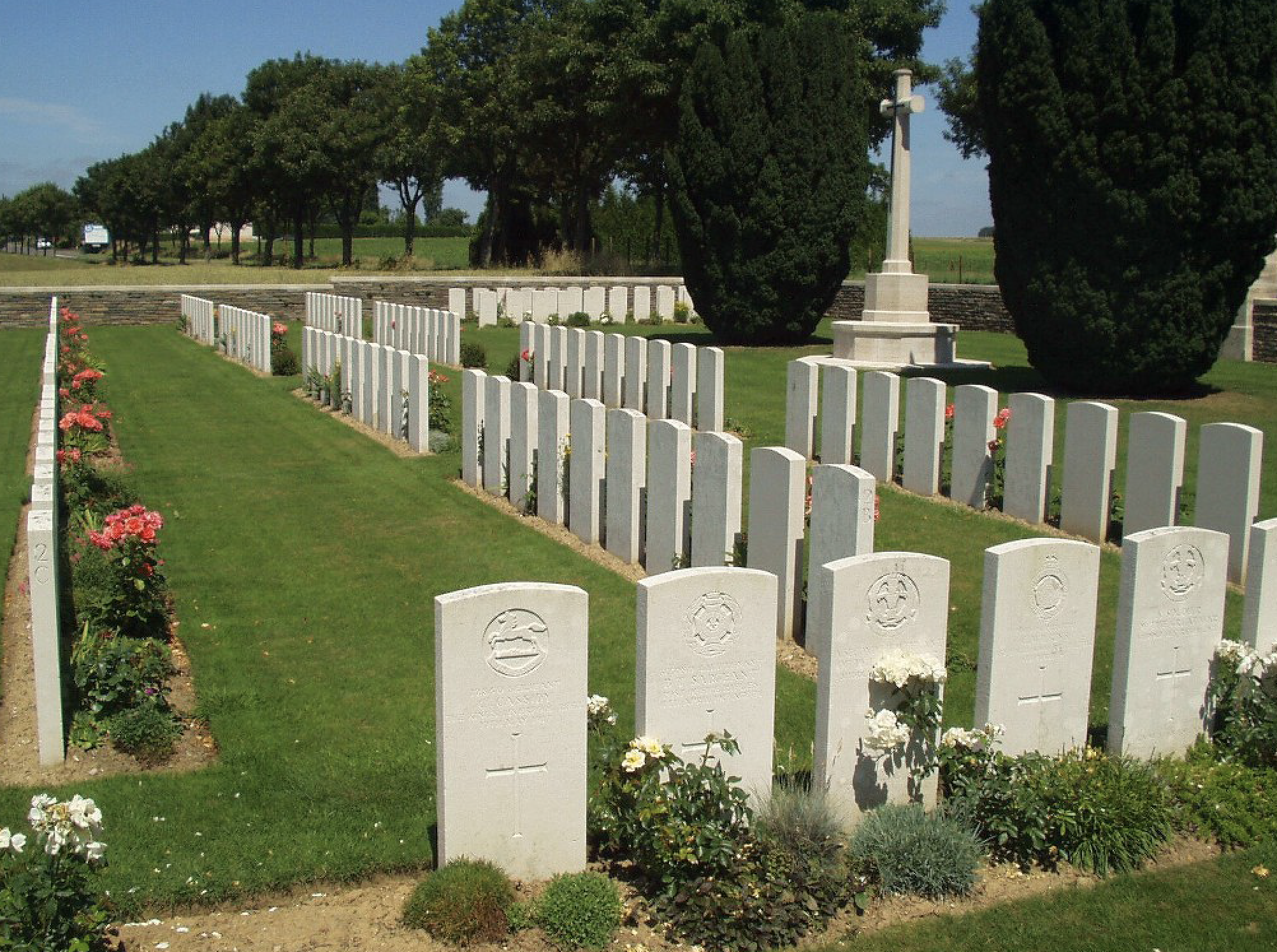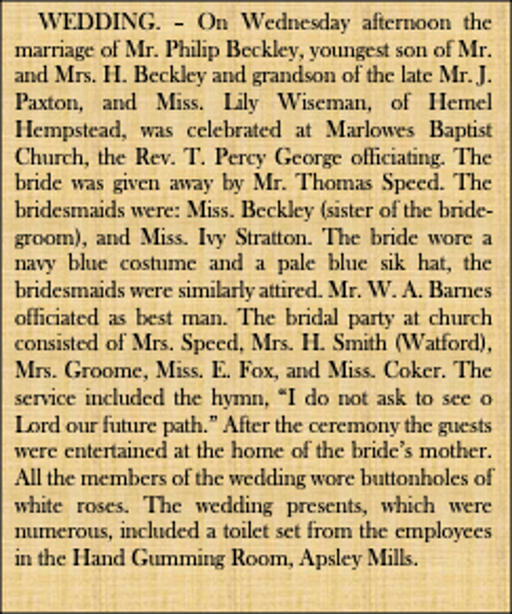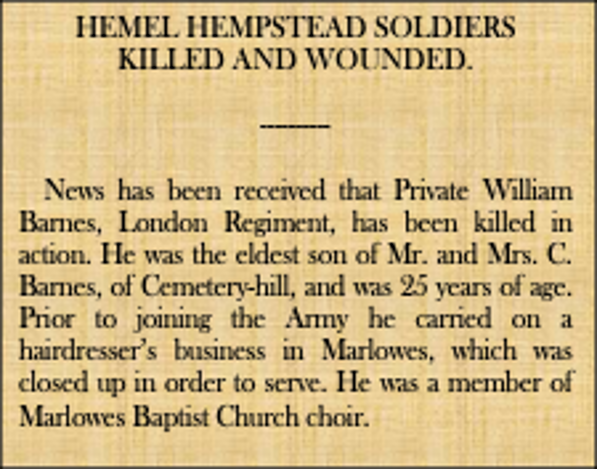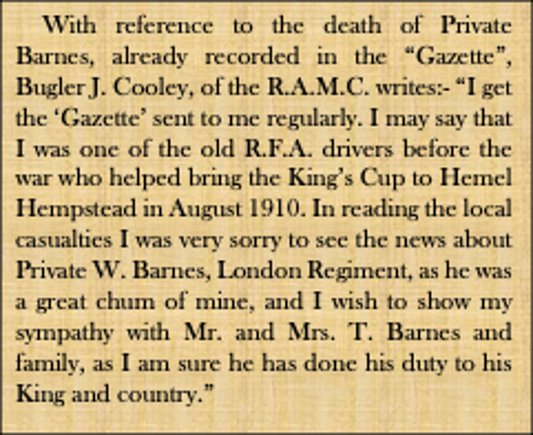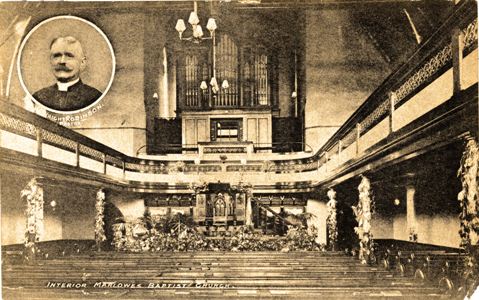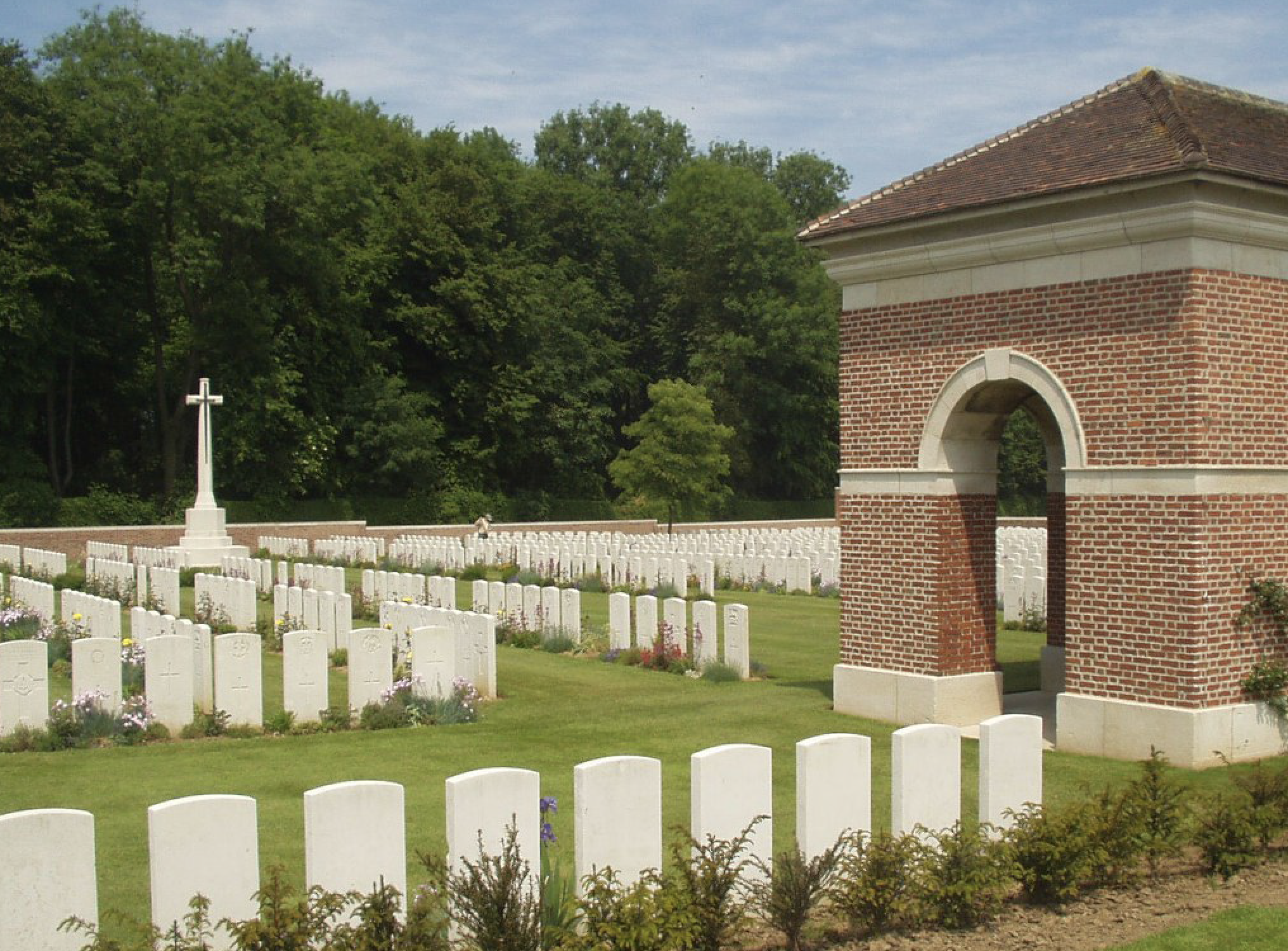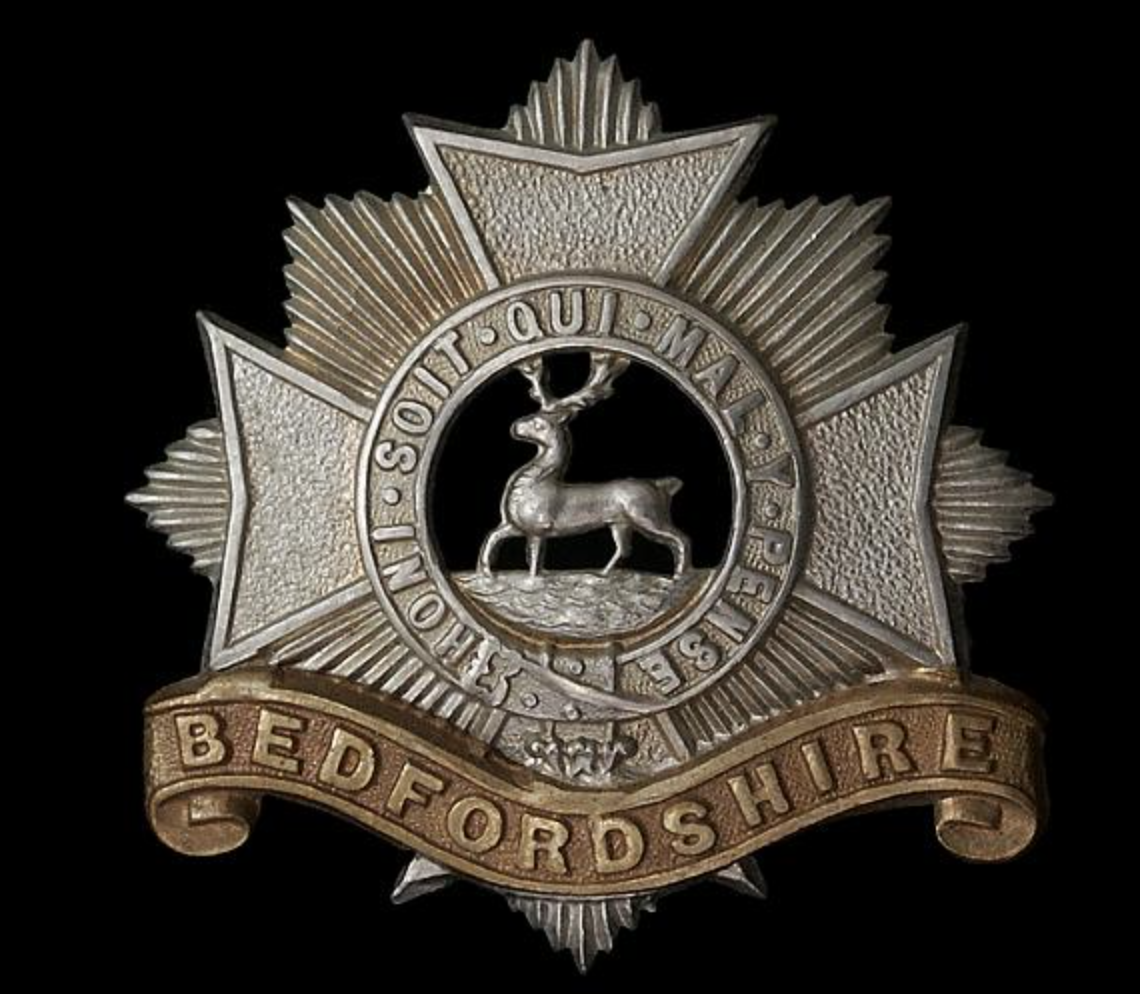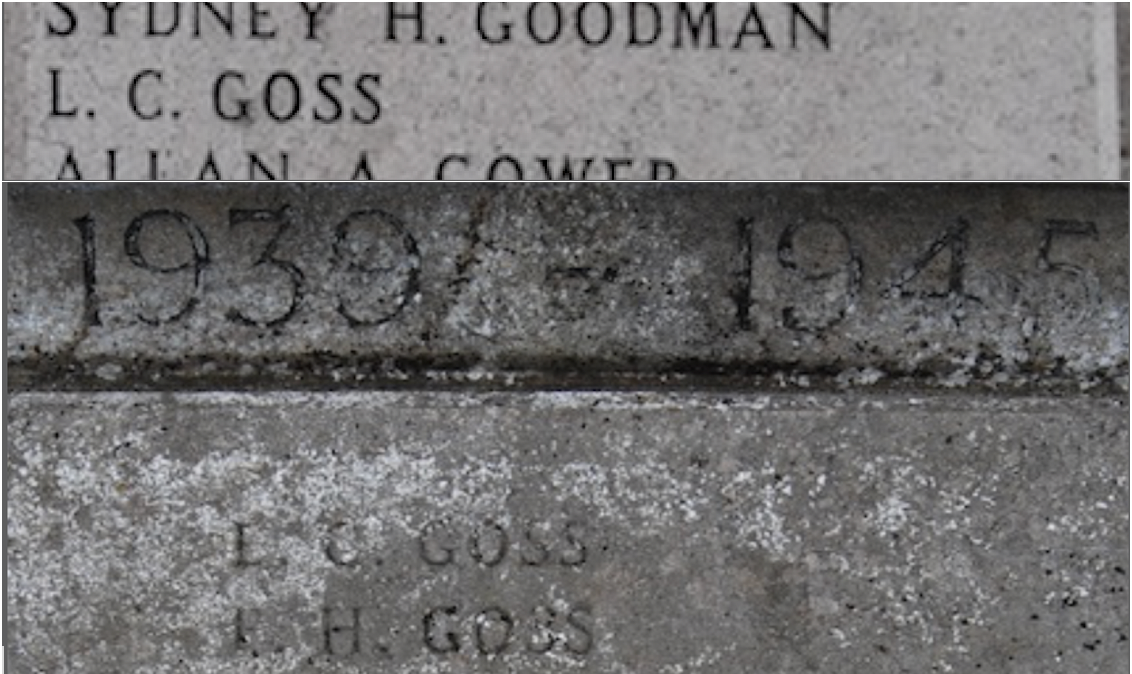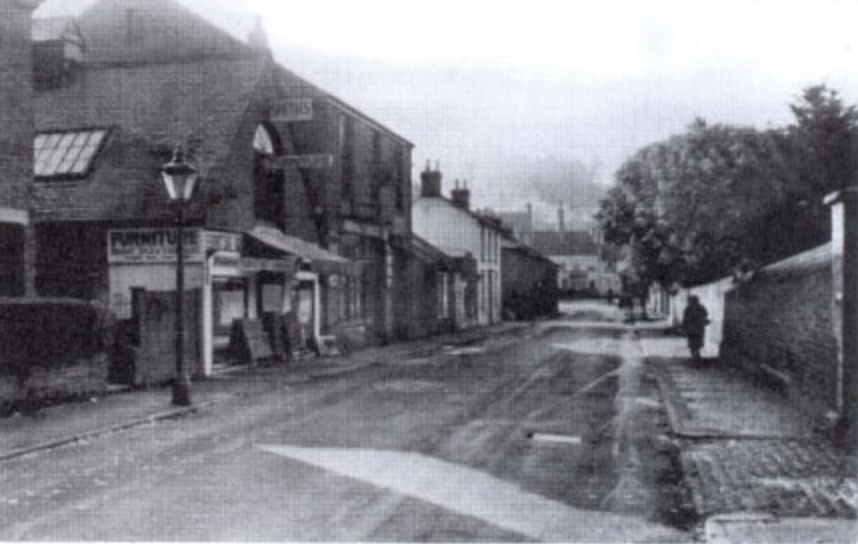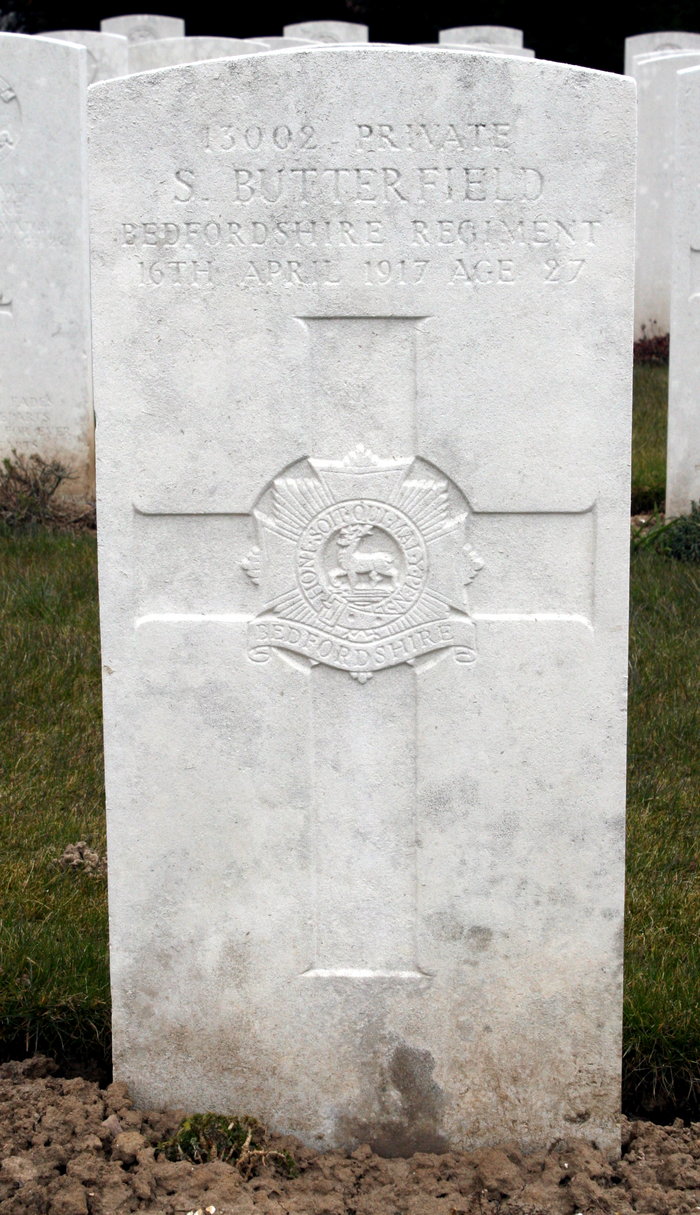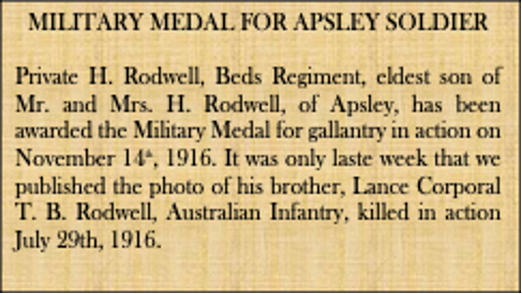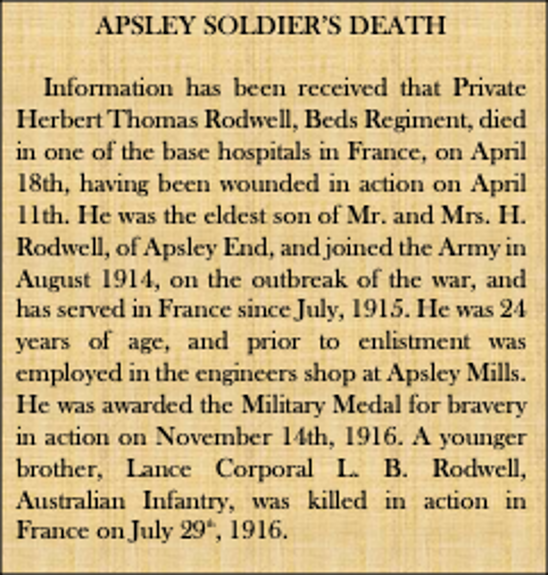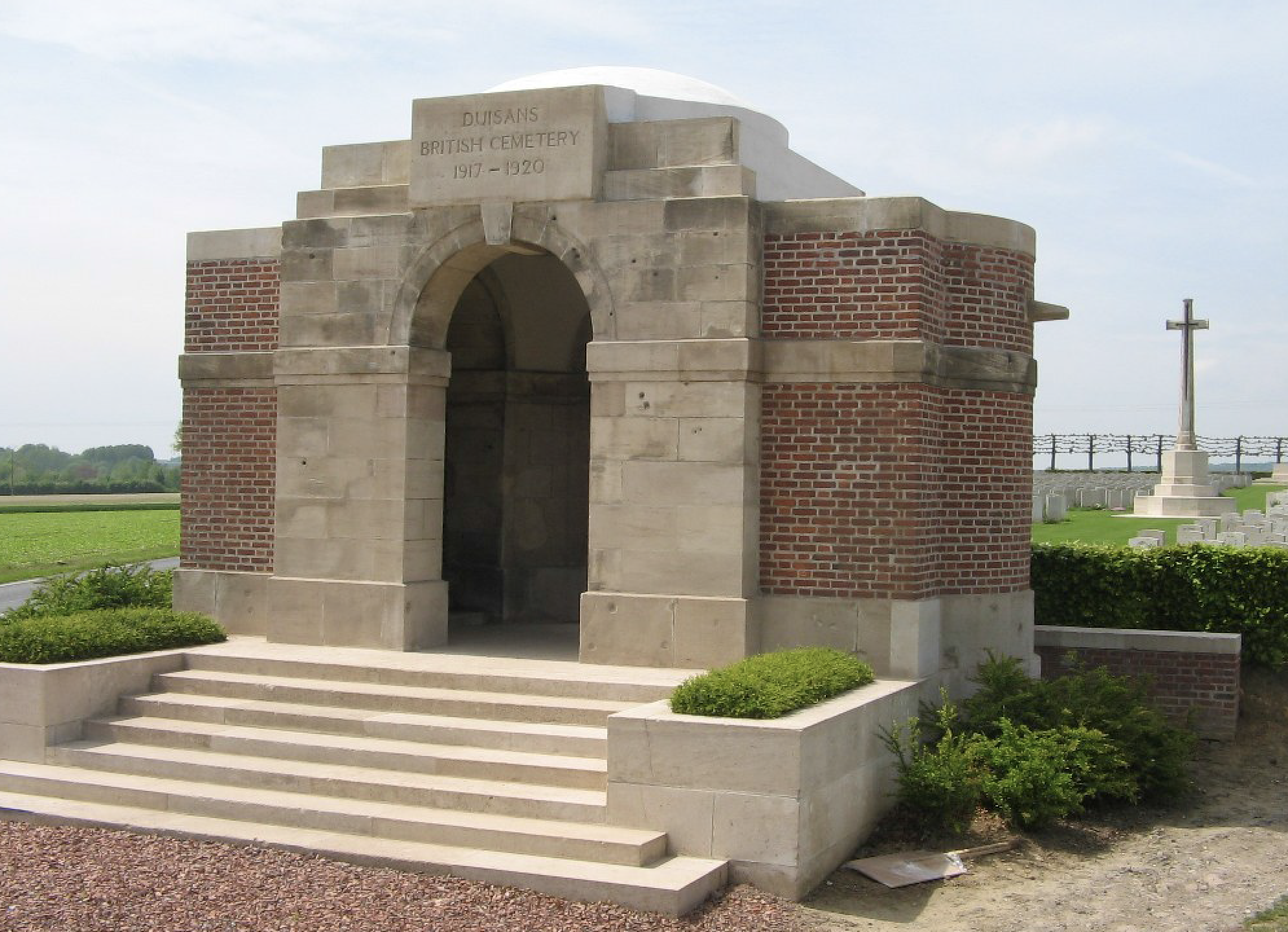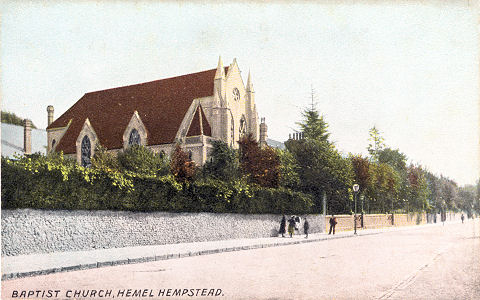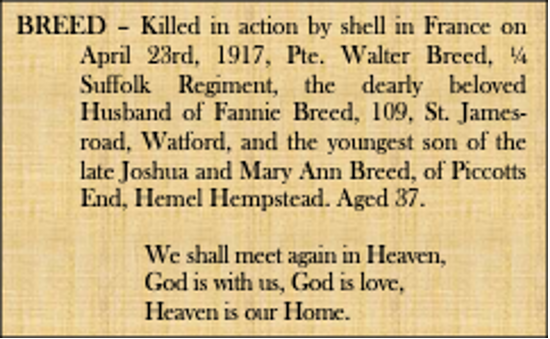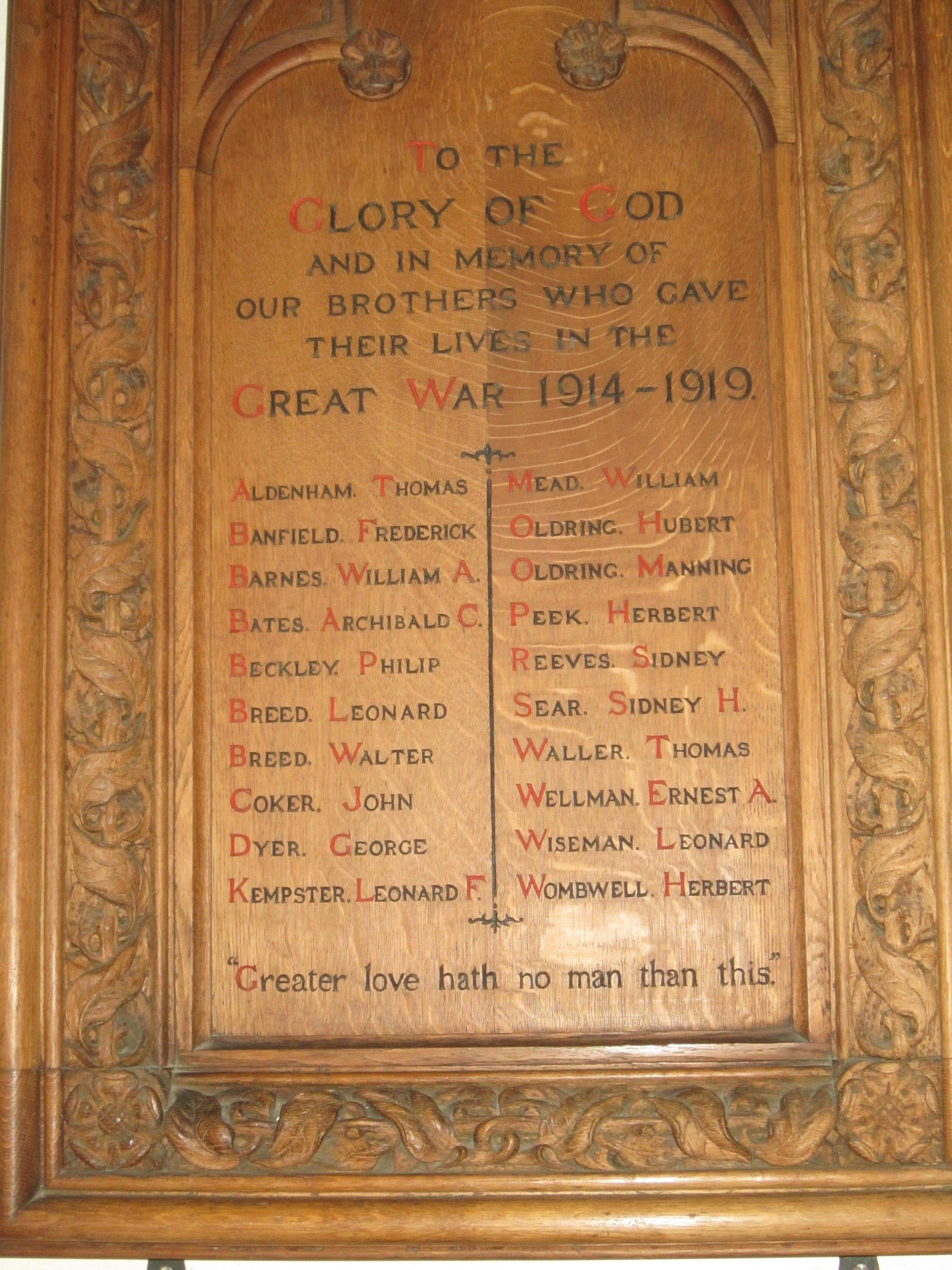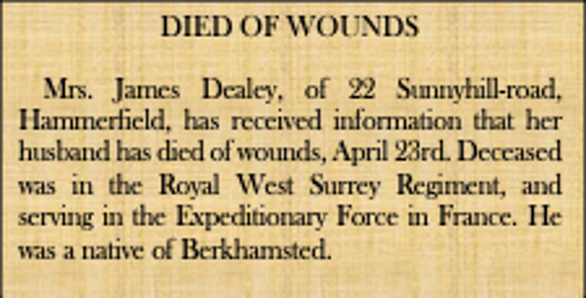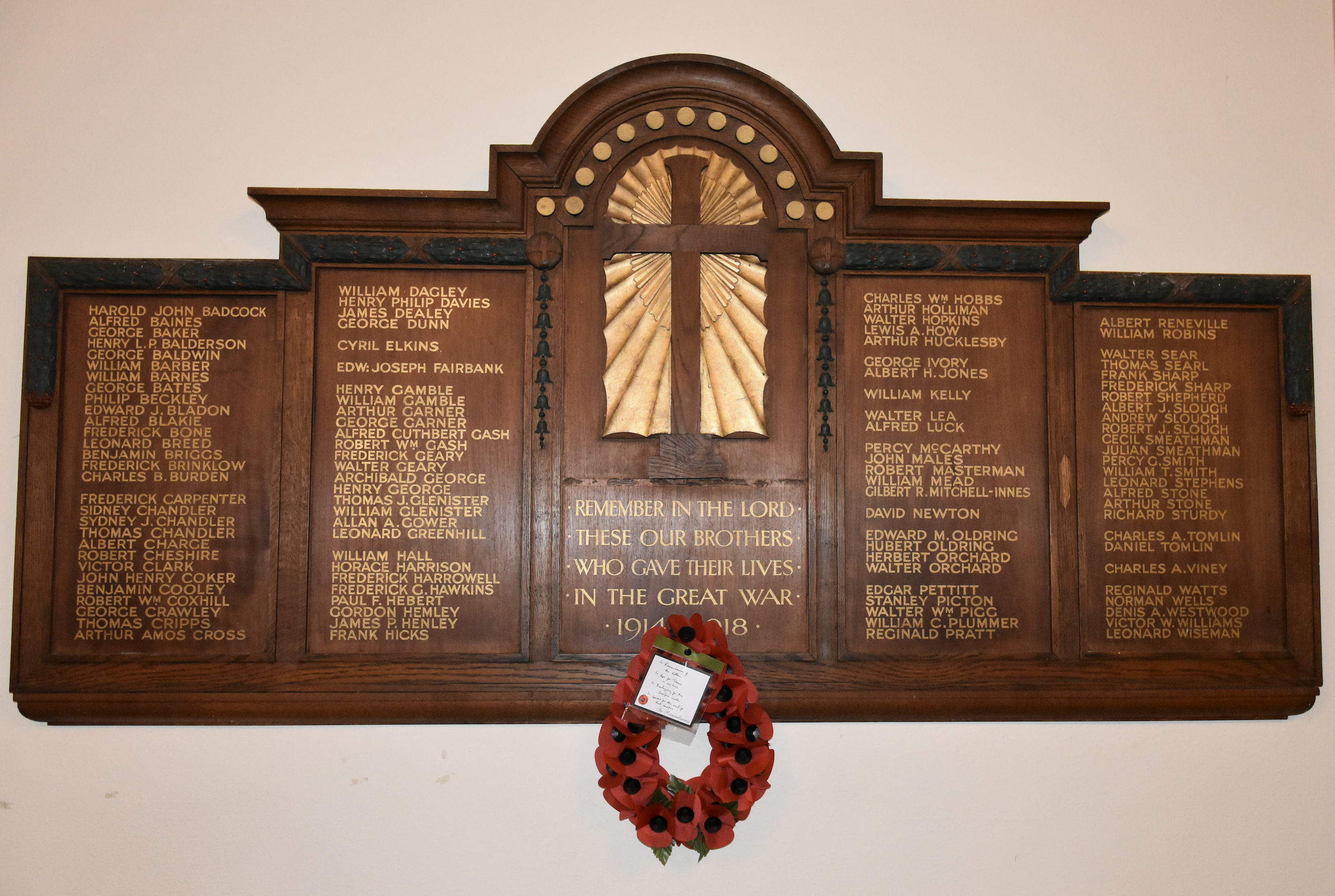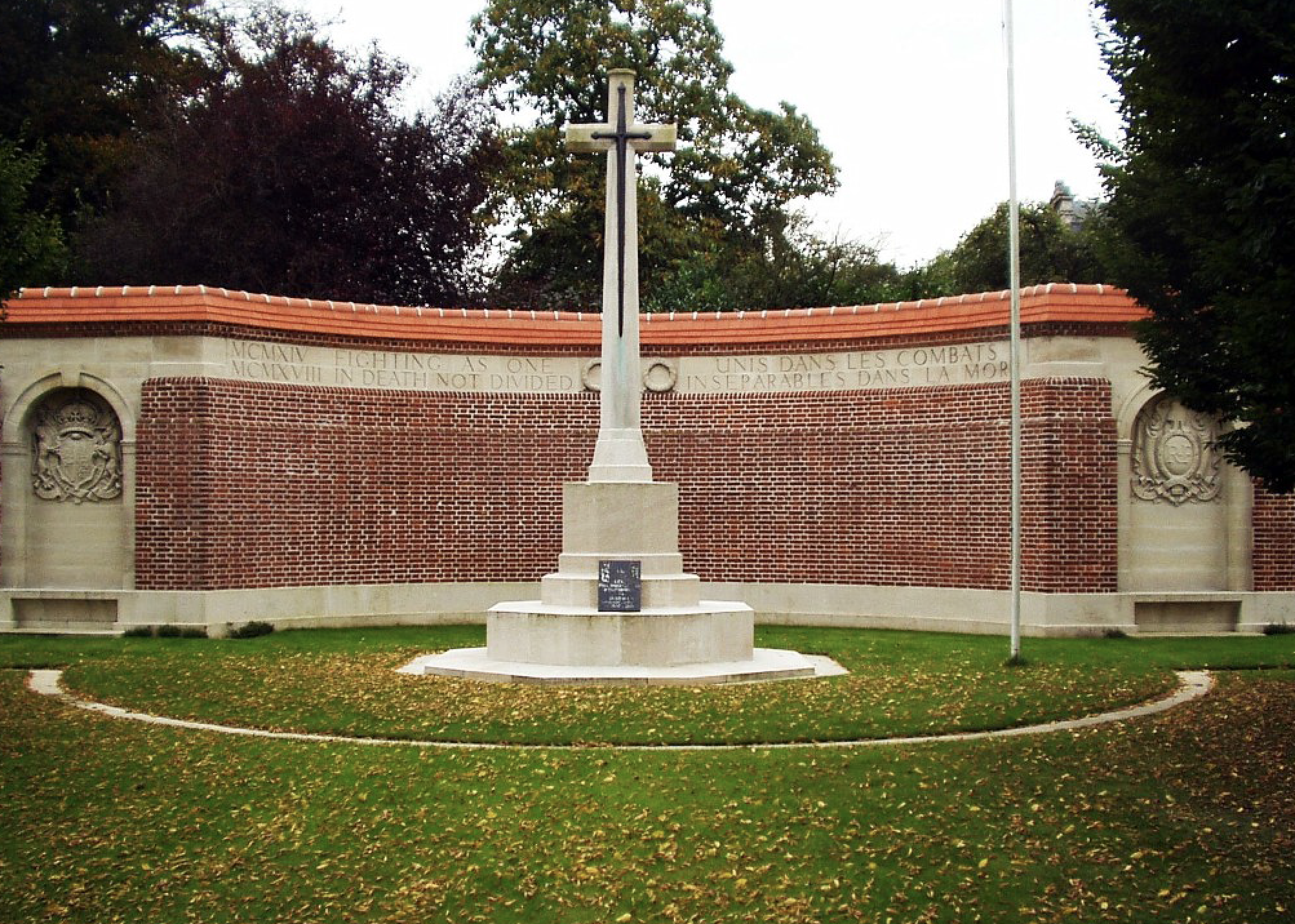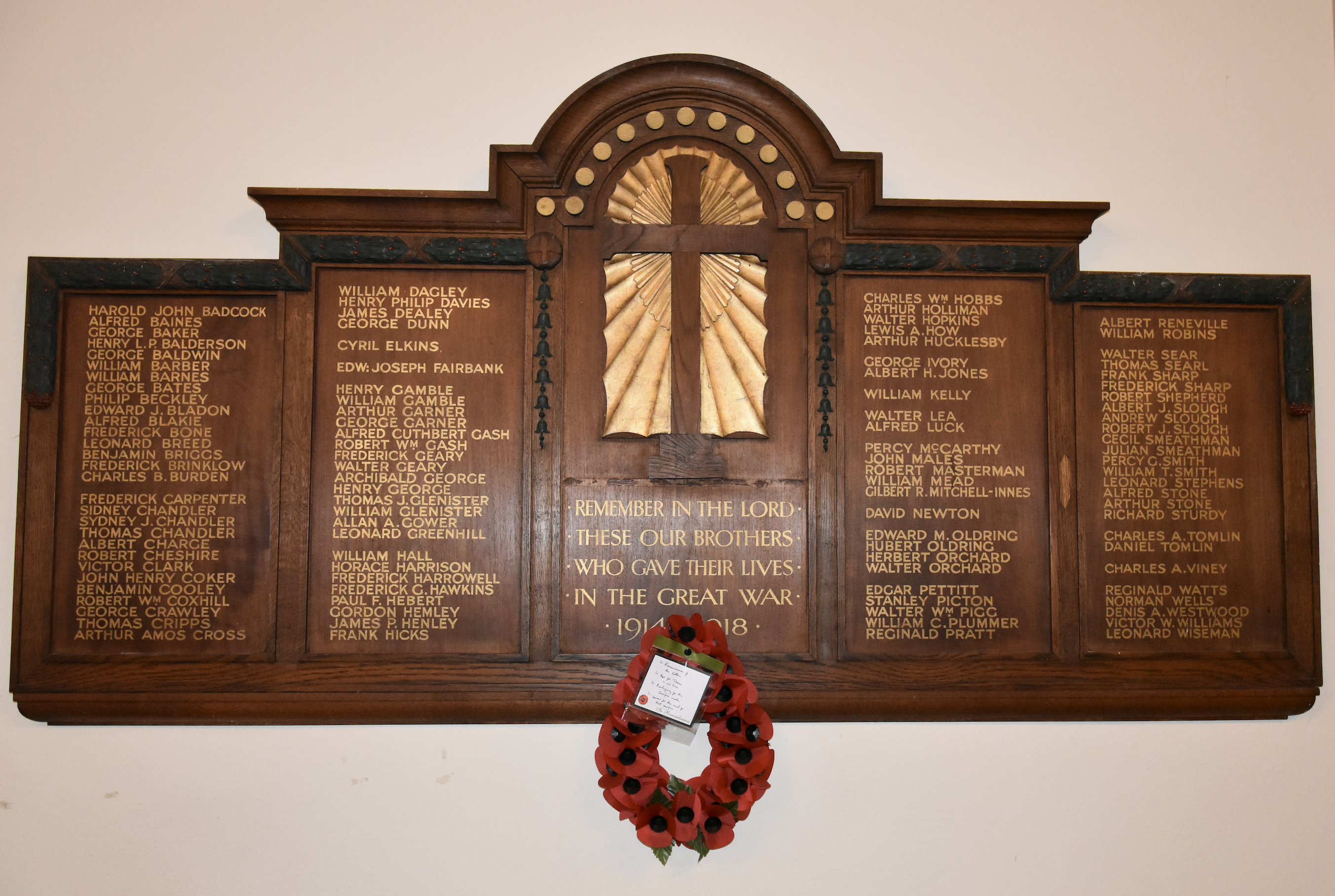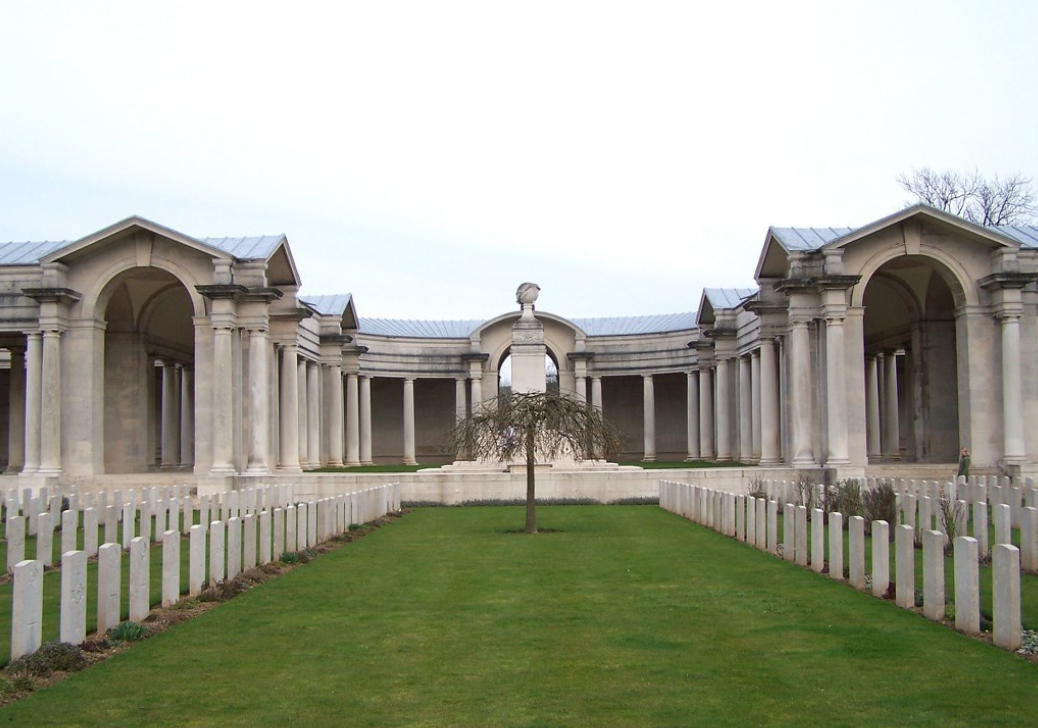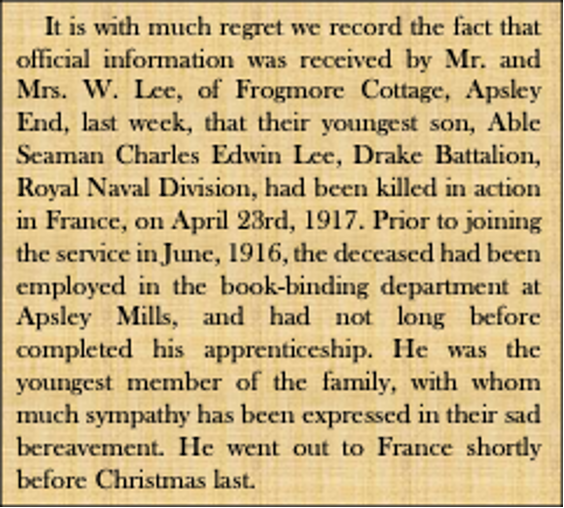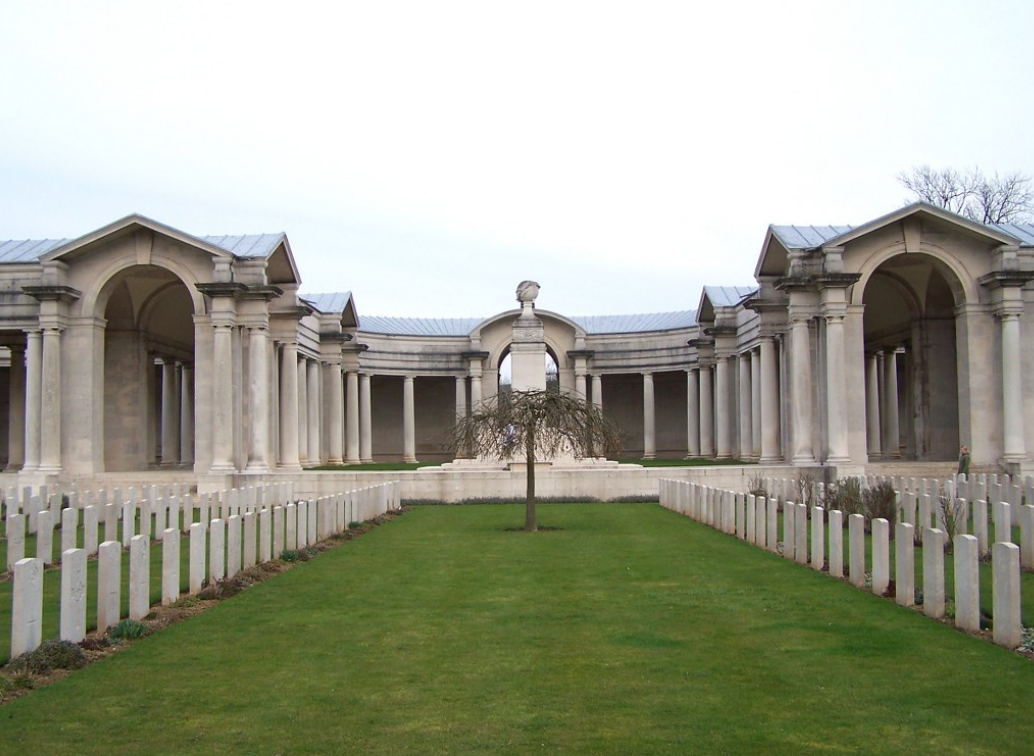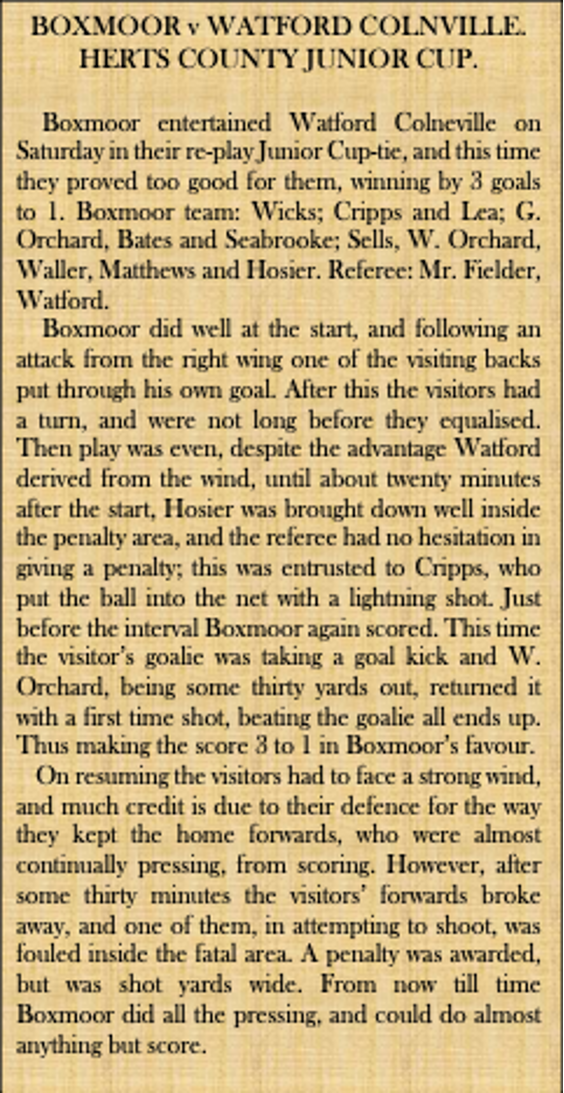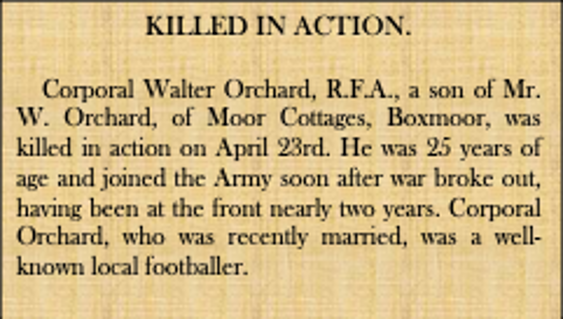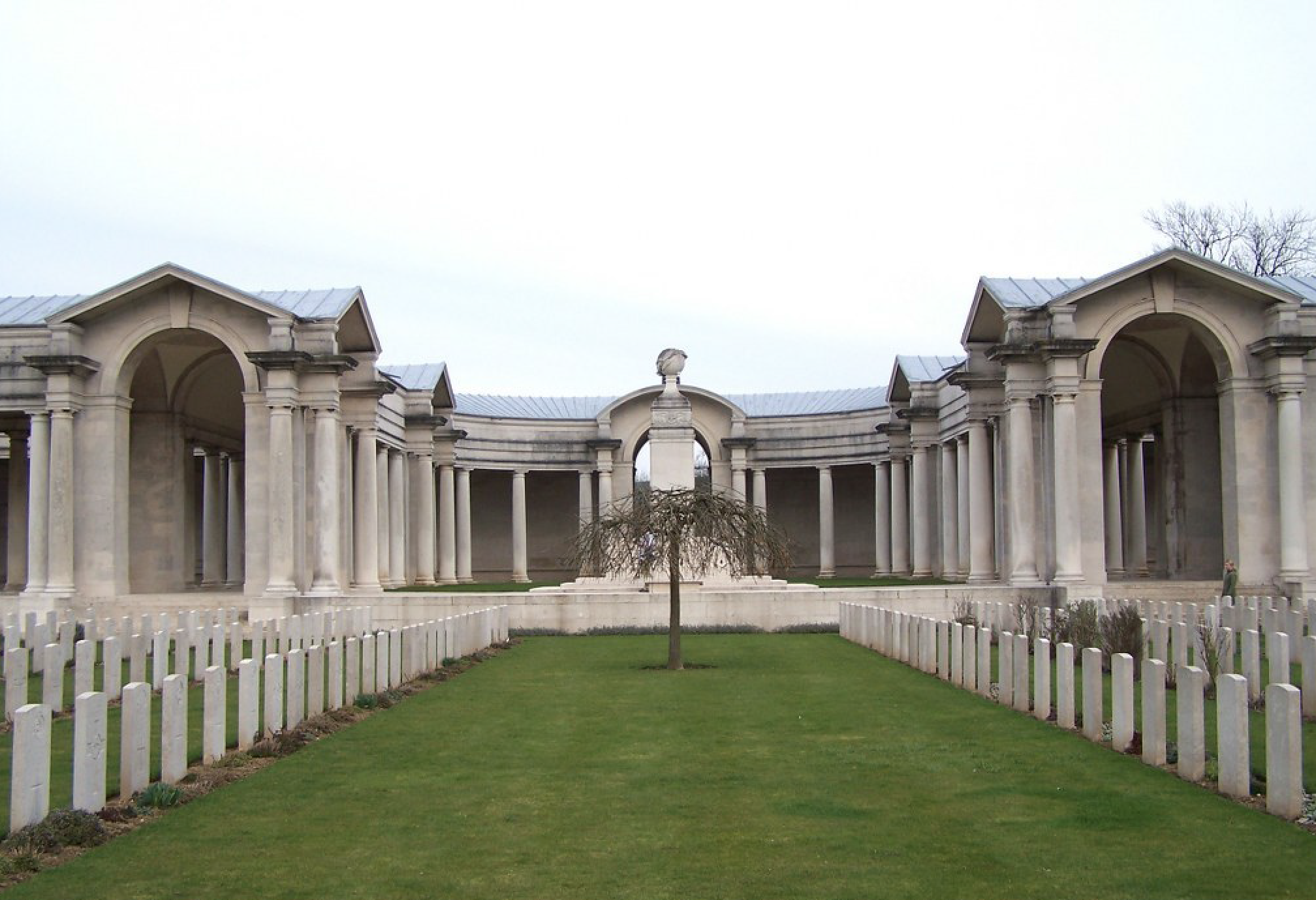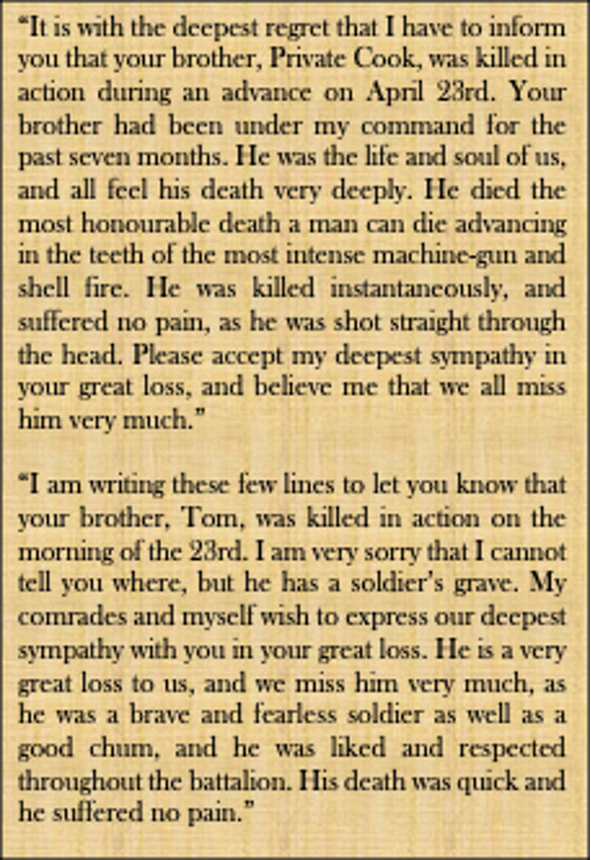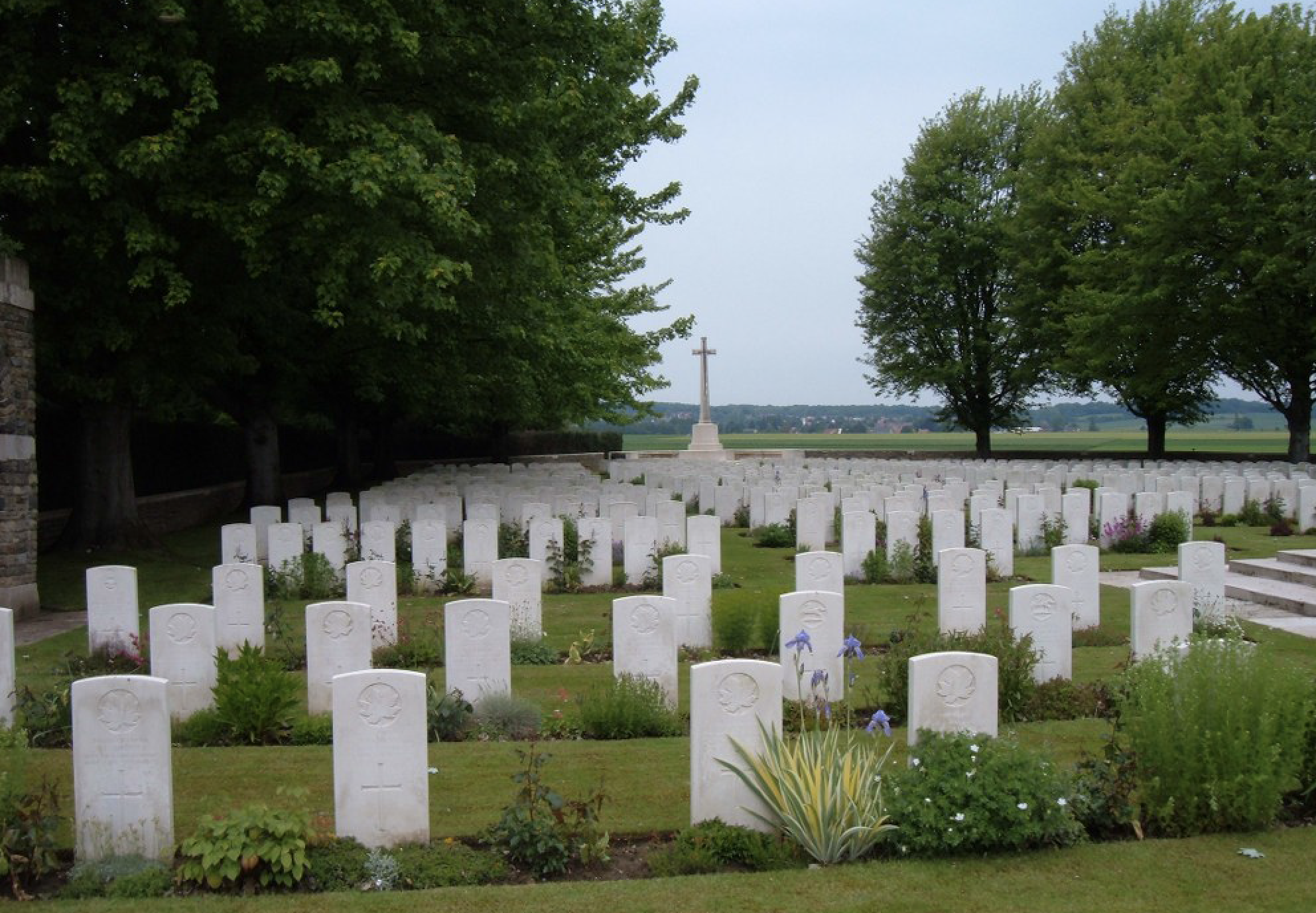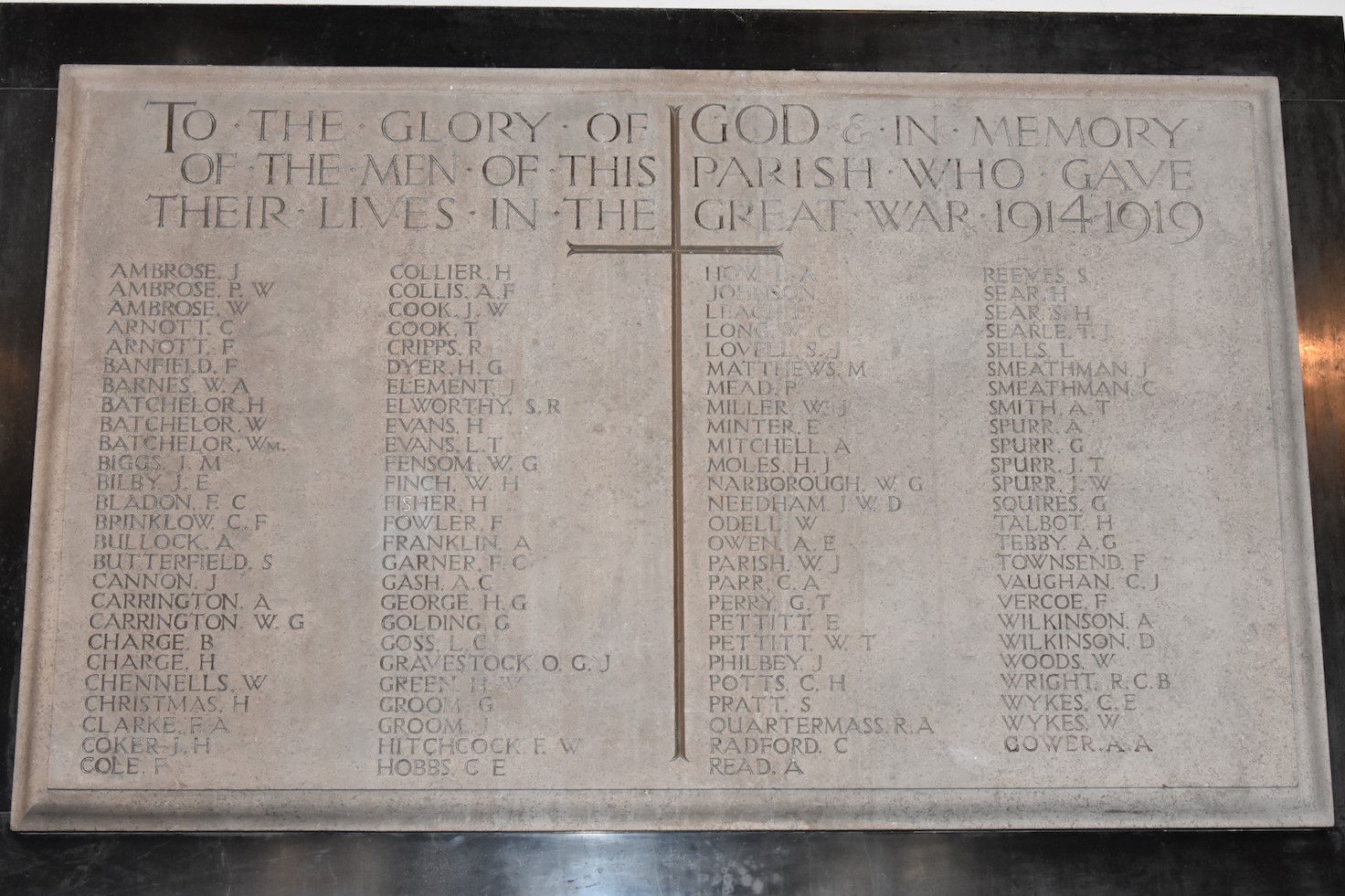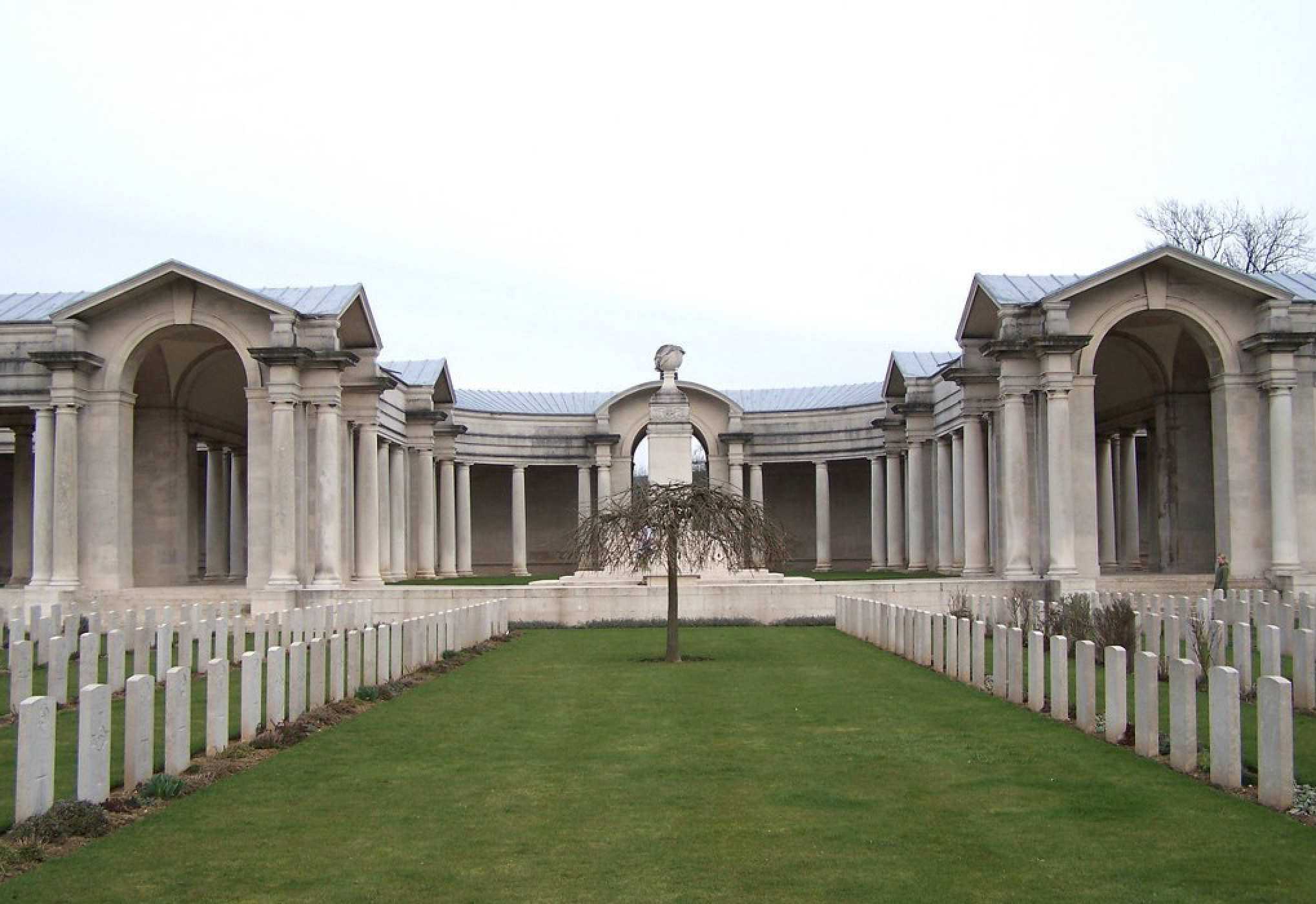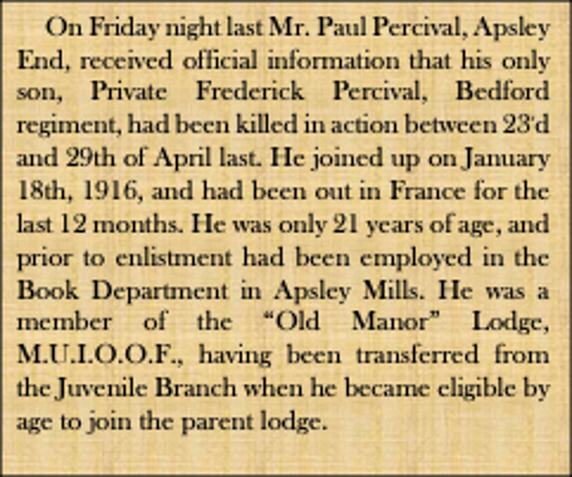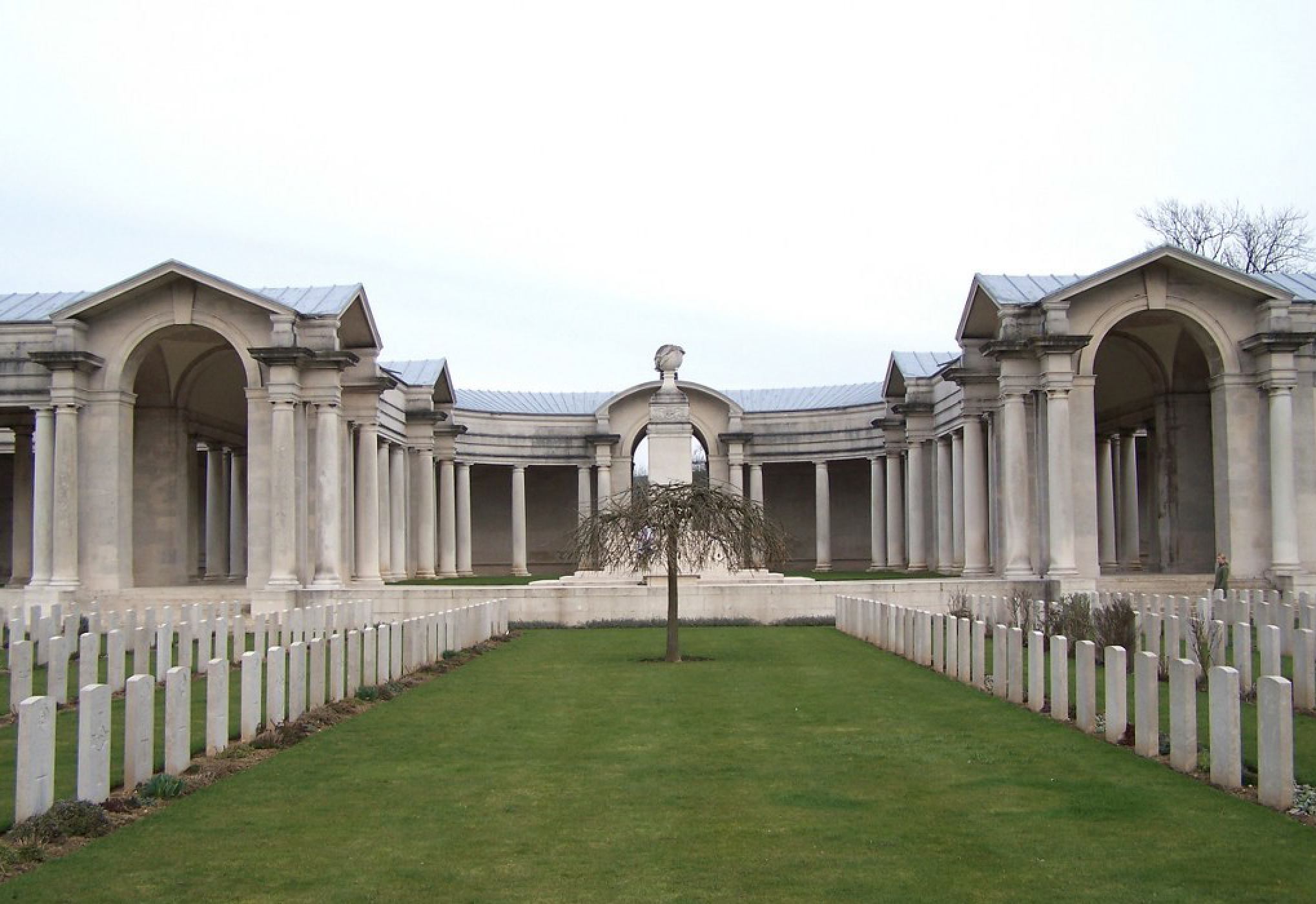Fallen in April 1917:
Richard William Wilkins
William Arthur Barnes
Leonard Charles Goss
Sidney Butterfield
Herbert Thomas Rodwell M.M.
Walter Breed
James Dealey
Arthur Thomas Holliman
Charles Edwin Lee
Walter Orchard
George Albert Timson
Thomas Cook
Oliver George Gravestock
Frederick Percival
RICHARD WILLIAM WILKINS
5605 Private
13th Kensington Bn., London Regiment
Killed in Action Monday, 9th April 1917
Remembered with Honour, London Cemetery, Neuville-Vitasse, Pas-de-Calais, France, Grave II. B. 12.
Richard William Wilkins, known as William, was born in 1887 to William and Milicent Snelling. His parents are recorded living in St. Leonards-on-Sea, Sussex on Richard’s Commonwealth War Graves record but it is not known if that is where Richard was born or whether they had moved there at a later date.
His links to the Hemel Hempstead area seem to be his employment with John Dickinson & Co Limited in Apsley Mills and St Mary’s Church in Apsley-End, where he was a member of the congregation.
William enlisted with the Colours in April 1915, attesting at St Leonards-on-Sea and joining the 28th (County of London) Battalion (Artist’s Rifles) which was based at Richmond Park Camp. When he completed his basic training, he was posted to the 1/15th (County of London) Battalion (Prince of Wales’s Own Civil Service Rifles) and sent to France.
He disembarked on the 22nd June 1916 and joined his Battalion at Souchez a few miles north of Arras where he was soon in action in the trenches. William had been in France for less than a month when he was one of three men wounded by enemy shell fire on the 19th July at Berthonval, and he was taken down the line to hospital.
His wounds were serious enough that he was evacuated to hospital in England where he spent a number of months in recovery before he was fit enough to go back to the Front. He was posted to the 1/13th (County of London) Battalion (Kensingtons), which had trained at Abbots Langley on mobilisation in 1914 before going to France, and William now joined his new battalion in mid-January 1917 at Bailleul just north of Armentières.
By April, the 13th Kensingtons had moved south to Achicourt outside Arras and engaged in early preparation for the ‘Nivelle Offensive’ which was the preliminary action in the Battle of Arras. At 5.30 a.m. on the 9th April the Battalion attacked the village of Neuville-Vitasse to the south of its position. All companies achieved their objectives quickly and experienced relatively little opposition before consolidating late in the day.
Despite the lack of significant resistance from the enemy there were casualties, and the Battalion War Diaries recorded 128 in total of which forty-three men were Killed in Action, practically all from shell fire. The Diary also noted that it was: “The most successful days fighting since the Bn. came to France”.
William was one of the unfortunate men killed and he died on Monday, 9th April 1917.
He was commemorated on the Memorial Plaque in St Mary’s Church Apsley-End.
William is Remembered with Honour in London Cemetery, Neuville-Vitasse, Pas-de-Calais, France where he is interred in Grave II. B. 12.
St Mary’s Church, Apsley End Memorial Plaque (Photo: Traquair Photography)
John Dickinson and Co. Limited War Memorial, Apsley End (Photo: Traquair Photography)
London Cemetery, Neuville-Vitasse, Pas-de-Calais, France (Photo: CWGC)
He was 30 years old when he died.
William was entitled to the British War Medal and the Allied Victory Medal.
WILLIAM ARTHUR BARNES
40816 Private
2nd Bn., Suffolk Regiment
Killed in Action Wednesday, 11th April 1917
Remembered with Honour, Tilloy British Cemetery, Tilloy-Les-Mofflaines, Pas-de-Calais, France, Grave IV. C. 18.
William Arthur Barnes was born in Berkhamsted, Hertfordshire on Monday, 11th April 1892, the oldest boy born to Thomas Barnes and Eliza Jane Gravestock. William had five siblings who were his older sister Dorothy, and Benjamin George, Elsie Mary and Charles Redvers who were all younger. He had another brother or sister whose name is unknown and who died in infancy.
The Barnes family moved to Hemel Hempstead not long after William was born and settled on Alma Road, which was situated between Marlowes and Bury Road where West Herts College stands today. William’s father Thomas worked in the grocery trade as a ‘Warehouseman’.
On the 1901 Census return William was not at home with his family; instead he was recorded as a ‘Visitor’ a few doors away with Philip and Sarah Reeve and their young daughter Elsie. Also staying with the Reeve family was one George Dean who worked locally as a ‘Hairdresser’ and who would later give young William his start in working life. It is not known if the Reeve family was related to William in any way and it may have been that he was just visiting a young friend, Elsie Reeve, when the Census enumerator called.
His acquaintance with George Dean however, resulted in William’s entry to the hairdressing trade when he left school in 1906 and started work in George’s business at 134a Marlowes. He stayed with George’s business until at least 1911 when he was recorded as a ‘Hairdresser (Assistant)’ on that year’s Census return and was living with his family at 16 Cemetery Hill in Hemel Hempstead.
Not long after this time William left George Dean’s employ to set up his own hairdressing business on the Marlowes and ran this successfully until he was called up for service in 1916.
In January of that year William had the happy duty to serve as ‘Best Man’ at his friend Philip Beckley’s wedding, which was reported in the Hemel Gazette a few days later. (see extract)
William and Philip were next-door-neighbours on Cemetery Hill, and both young men were active members of Marlowes Baptist Church where William was also a member of the Church Choir. Tragically his friend Philip died only seven months before William, at the end of September 1916. Philip’s biography also appears on this site.
William closed up his business in Hemel Hempstead and went to attest at Whitehall in London in May 1916, when he joined the London Regiment. Although the battalion is not known, it may have been the 12th (The Rangers) Battalion London Regiment which his friend Philip had joined a few months earlier. Nor is it known when William went to France, although this is likely to have been at the end of 1916 or very early in 1917.
Having enlisted with the London Regiment, William was subsequently transferred to the 2nd Battalion Suffolk Regiment on his arrival in France and soon found himself in the trenches. The 2nd Suffolks was part of the 9th Infantry Brigade which took part in the Battle of Arras starting on the 9th April 1917.
William and his colleagues made good progress on the first morning of the attack and although over one hundred casualties were incurred on the day, the Battalion reached its objectives and spent the next twenty-four hours consolidating its gains and making ready to advance for a second time.
On the 11th April the situation had changed, and the initial assembly was very slow due to ‘thick wire’ and heavy shelling from the enemy lines which the Battalion War Diary describes as “Woolly Bears”. This was a certain type of German shrapnel known as “The Woolly Bear,” from the thick white smoke emitted when it burst.
Shortly after the start of the attack the action was described as follows: “The advance was made under a considerable amount of shelling but on coming into view of GUEMAPPE down the convex slope of the ridge, the lines met heavy Machine Gun Fire from WANCOURT on their right flank as well as from GUEMAPPE.”
During these actions the 2nd Suffolks suffered 120 casualties, 13 of which were ‘Killed in Action’ and the War Diary goes on to record the following observations of that day’s efforts:
“The difficulties met with in the operations of the 11th April were:
(1) The troops were tired.
(2) No time for personal reconnaissance and formation of plan of attack.
(3) No artillery support.
(4) WANCOURT was not in our hands.
The lesson to be learnt appears to be the vital necessity of locating Machine Guns by very widely extended line of scouts who can shoot supported by one or two Lewis Guns to attract attention and engage Machine Gun while other parties work round.”
William was one of the 13 men killed and he died on Wednesday, 11th April 1917, poignantly his twenty-fifth birthday.
William’s death was reported in the Hemel Gazette shortly after he was killed. (see extract)
Another of his friends, ‘Bugler’ J Cooley of RAMC, on hearing of William’s death felt moved to write to the Gazette expressing his sympathy. (see extract)
He was commemorated on the Memorial Plaque inside Marlowes Baptist Church where he was a member of the congregation.
William is Remembered with Honour in Tilloy British Cemetery, Tilloy-Les-Mofflaines, Pas-de-Calais, France, where he is interred in Grave IV. C. 18.
He was exactly 25 years old when he died.
William was entitled to the British War Medal and the Allied Victory Medal.
Extract from The Hertfordshire, Hemel Hempstead Gazette and West Herts Advertiser 22nd Jan. 1916
The Battle of Arras 1917 where William fell. (Image: Public Domain)
“The Woolly Bear” (Photo: IWM)
Extract from The Hertfordshire, Hemel Hempstead Gazette and West Herts Advertiser 28th Apr. 1917
Extract from The Hertfordshire, Hemel Hempstead Gazette and West Herts Advertiser 5th May 1917
Marlowes Baptist Church where William sang in the choir (Image: http://www.hertfordshire-genealogy.co.uk)
Tilloy British Cemetery, Tilloy-Les-Mofflaines, Pas-de-Calais, France (Photo: CWGC)
LEONARD CHARLES GOSS
4/7254 Lance Corporal
2nd Bn., Bedfordshire Regiment
Killed in Action Wednesday, 11th April 1917
Remembered with Honour, St. Martin Calvaire British Cemetery, St. Martin-Sur-Cojeul, Pas-de-Calais, France, Grave I.A.29.
Leonard Charles Goss was born in the Summer of 1881 in St Pancras in London. He was the third child born to William Goss and Mary Ann Harris who had five children together. Leonard’s siblings were: William James, Ada Florence, John and Grace Dorothy.
Leonard grew up in St Pancras where his father William worked as a ‘Plumber’ and after leaving school in 1894, Leonard started work with a manufacturing company in London and was trained to make gas meters. In the late 1890s he met Edith Annie Adams and they became sweethearts but before they were married Leonard’s mother Mary Ann died in 1899 aged only forty.
Edith had been born in India in 1882 where her father William had been serving as a Serjeant in the Royal Artillery and on the Saturday, 16th February 1901, she and Leonard were married in St Pancras.
A year later the young couple had moved from London to Berkhamsted in Hertfordshire where Leonard’s mother had come from. Shortly after arriving, Edith gave birth to their first child, a daughter whom they named Grace Beatrice. In the next twelve years the family grew with the births of Mabel Florence, Edward Charles, Ellen Maud, Robert James, Frederick Henry and Ernest John. Edward and Frederick were both killed on active service in World War Two, and their names are commemorated on the Hemel Hempstead War Memorial along with their father.
On 21st November 1904, Leonard enlisted in the Militia joining the 4th Battalion Bedfordshire Regiment at Hertford. He was not quite twenty-two and was working as a ‘Bricklayer’ for George Whitman at Little Gaddesden. He was described as being 5ft 3ins tall, weighing 112lbs (8st), with a fair complexion, hazel eyes and dark brown hair. He was considered ‘Fit’ and underwent a total of sixty-three days training and attended the Annual Camp in 1905. In April 1906, Leonard paid a £1 fee to buy his discharge from the Army and returned to his civilian life in Berkhamsted.
On the outbreak of war, Leonard re-enlisted with the Bedfordshire Regiment, attesting in Hemel Hempstead in September 1914 and following refresher training he was sent to France where he disembarked at Le Havre on the 2nd February 1915.
Given his previous military experience he was soon promoted Lance Corporal and during 1915 he fought in the Battles of Neuve Chapelle in March, Festubert in May, Givenchy in June and Loos in September. He survived all of these engagements but much more was still to come in 1916.
On the 1st July 1916 the 2nd Bedfordshires fought in the Battle of Albert the first major engagement of the Somme offensive. Over the next five months Leonard saw action at Bazentin Ridge, Delville Wood, Pozières, Flers-Courcelette, Thiepval and Transloy Ridges and finally, Ancre in November. He came through these horrific battles unscathed once again, but his luck would run out a little over five months later.
In April 1917, the 2nd Battalion Bedfordshire Regiment fought in the Battle of Arras and it was here that Leonard met his end. On the third day of the attack the Battalion War Diary recorded the following: “11 Apr 1917 At 4 a.m. Battalion Hd.Qrs.[sic] moved up to N.32.d.0/6. At 5.30 a.m. attack started SOUTH OF RIVER. "D" in front. "A" in Support. NORTH OF RIVER "B" in front. "C" in Support. Attack held up almost at once, came under heavy enfilade M.G. fire and wire was uncut. German Trenches very strongly held. "D" and "A" Companies dug in about N.33.b.7/8 to N.33.b.6/2. "B" Company dug in about N.27.c.7/4 and held on there. "C" Company remained in Support to "B" Company. The attack by 21st Division on our RIGHT was held up. At 10 a.m. 4 Tanks appeared on our Left and crossed German Line. They were of no assistance as no scheme of co-operation with us had been worked out.”
During the six hours of this action the Battalion incurred a total of eighty-nine casualties comprising: “OTHER RANKS Killed 13. Died of Wounds 4 Missing 2 Wounded 63 Wounded at duty 5 Shell Shock 2”.
Leonard was one of the thirteen men who fell on Wednesday, 11th April 1917.
Bedfordshire Regiment Cap Badge pre-1919 (image: https://www.northeastmedals.co.uk)
Leonard, Edward and Frederick on the Hemel Hempstead War Memorial (Image: Traquair Photography)
St. Martin Calvaire British Cemetery, St. Martin-Sur-Cojeul, Pas-de-Calais, France (Photo: CWGC)
When Leonard died his children were all under the age of fifteen and the youngest Ernest John was only six months old. Edith was left to raise their young family alone and was awarded an Army pension totalling 36s 3d per week which diminished by 2s 6d per week as each child reached the age of sixteen. The sum awarded was approximately equivalent to £97 today and was barely enough at the time to feed, clothe and raise a young family of seven children. This was a common situation during the Great War and in many cases widowed wives would remarry or at the very least go out to work, in order to have enough to raise their families.
Leonard is Remembered with Honour in St. Martin Calvaire British Cemetery, St. Martin-Sur-Cojeul, Pas-de-Calais, France where he is interred in Grave I.A.29.
He was 35 years old when he died.
Leonard was entitled to the 1914 – 15 Star, the British War Medal and the Allied Victory Medal.
SIDNEY BUTTERFIELD
13002 Private
6th Bn., Bedfordshire Regiment
Died of Wounds Monday, 16th April 1917
Remembered with Honour, Cabaret-Rouge British Cemetery, Souchez, Pas-de-Calais, France, Grave XVII. J. 35.
Sidney Butterfield was born in Hemel Hempstead on Monday, 8th April 1889 the sixth child of Frederick Butterfield and Mary Ann Bunyon. Frederick and Mary Ann had a large family of ten children who were: Frederick, George, Annie, Thomas, Charles, Sidney, Ellen, Lizzie, William and John. Thomas died in 1888 aged two and Ellen died in 1892 aged one.
When Sidney was born his family lived at the Masons Arms on Bury Road in Hemel Hempstead where his father was the pub landlord. In May 1897 when he was eight years old Sidney and his brother Charles moved from Piccott’s End Infants school to Boxmoor JMI. On October 7th, 1898 the school log recorded that Sidney was “reported to the Attendance Officer for truanting”. The reason for his truancy is not revealed but given the time of year it may have been the temptation to go ‘scrumping for apples’. Sidney stayed at Boxmoor for two more years before transferring to Hemel Hempstead Boys school where he completed his education in 1902.
By that time his family had moved to Cemetery Road and his father Frederick had given up running the Masons Arms and instead worked as a ‘General Carrier’. When he started work, Sidney joined his brother George as a ’Carman’ assisting their father. They were the equivalent to a modern day ‘courier’ transporting goods and packages for delivery around the Hemel area.
Sidney’s father Frederick died in 1912 aged fifty-six by which time all the children had left school and found employment and they lived with their mother Mary Ann at 89 Cotterells. Shortly after his father’s death, Sidney married his sweetheart Lily Room. Lily was from Dunstable, Bedfordshire but had come to Hemel Hempstead to work with John Dickinson & Co Limited in Apsley Mills. She and Sidney married in Hemel Hempstead late in 1912 and Lily would remarry a year after Sidney’s death to another Hemel man, Thomas Shakespeare.
On the outbreak of war Sidney joined the Colours, attesting at Hemel Hempstead in September 1914 and joining the Bedfordshire Regiment. He was posted to the newly formed 6th ‘Service’ Battalion and went to Aldershot to train with the 9th (Scottish) Division. He moved with the Battalion when it transferred to the 37th Division at Andover in March 1915 for further training on Salisbury Plains. Finally, the 6th Bedfordshires transferred into the 112th Brigade and on completion of training mobilised for overseas service in July 1915.
The Battalion embarked for France at Southampton aboard the SS Empress Queen and disembarked at Le Havre on the 30th July 1915. For the rest of that year Sidney saw no significant action and was mainly engaged with his comrades in general trench work, training and reconnaissance.
All this changed in mid-1916 when Sidney fought in the Battle of Bazentin Ridge, part of the great Somme offensive. He then fought in the Battle of Pozières a month later before fighting in the last major offensive of the Somme campaign in November, the Battle of Ancre.
Five months later he found himself near Arras preparing for the next major battle and on the 10th April, he went into action again at the First Battle of the Scarpe. It appears that Sidney was wounded at some point on the 13th or 14th April and he was taken down the line to No.51 Field Ambulance where sadly, he succumbed to his wounds.
Sidney died on Monday, 16th April 1917.
Sidney is Remembered with Honour in Cabaret-Rouge British Cemetery, Souchez, Pas-de-Calais, France where he is interred in Grave XVII. J. 35.
He was 27 years old when he died.
Sidney was entitled to the 1914 – 15 Star, the British War Medal and the Allied Victory Medal.
Pte. Sidney Butterfield c1914 (Photo: The Hertfordshire, Hemel Hempstead Gazette and West Herts Advertiser)
Bury Road where Sidney's father ran the Masons Arms (Photo:http://www.hemelatwar.org)
Headstone of Sidney Butterfield, Cabaret-Rouge British Cemetery, Souchez, Pas-de-Calais, France (Photo: Traquair Photography)
HERBERT THOMAS RODWELL M.M.
12912 Private
6th Bn., Bedfordshire Regiment
Died of Wounds Tuesday, 17th April 1917
Remembered with Honour, Duisans British Cemetery, Etrun, Pas-de-Calais, France, Grave III. B. 29.
Herbert Thomas Rodwell, known as Bert, was born in Hemel Hempstead in September 1892 and baptised a month later on Friday, 28th October in St John’s Parish Church in Boxmoor, Hertfordshire. He was the first child and oldest son born to Herbert William Rodwell and Minnie Bedford who had a large family of eleven children together. The children were: Bert (Herbert) Thomas, Thomas Bernard, Frederick, Winifred Eva, Ernest Frank, Dorothy, Lilias, Marjorie, Eva, Dennis and Arthur. Bert’s brother Frederick died on 30th September 1916 following a two-year illness and his brothers Bernard and Ernest also fought in the Great War. Ernest, a Wireless Operator in the Royal Navy, survived the conflict, but Ernest who had emigrated to Australia as a young man, was killed at the Somme in 1916 fighting for the Australian Infantry. Bernard’s biography also appears on this site.
When Bert was born, his family lived in Horsecroft Road in Boxmoor and his father worked as a ‘Steam Engine Fitter’ with John Dickinson & Co. Limited at Apsley Mills, where seven of his eleven children would also work at one time or another.
The family moved in the late 1890s to 77 Weymouth Street, Apsley and would remain at this address for the next seventy years, the last of the family moving out when Bert’s mother Minnie died in 1965.
By the time Bert was eighteen in 1911, he had been working with Dickinson’s at Apsley Mills for almost five years and was an ‘Apprentice Engineer’ in the Engineering Department. He was still with Dickinsons when war broke out and he immediately joined the Colours.
At the end of August 1914 Bert attested at Hemel Hempstead and joined the newly formed 6th ‘Service’ Battalion Bedfordshire Regiment. He went to Aldershot to train with the 9th (Scottish) Division before the Battalion moved to the 37th Division at Andover in March 1915 for further training on Salisbury Plains. Finally, the 6th Bedfordshires transferred into the 112th Brigade and on completion of training mobilised for overseas service in July 1915.
The Battalion embarked for France at Southampton aboard the SS Empress Queen and disembarked at Le Havre on the 30th July 1915.
The Rodwell’s were one of a number of Hemel families with more than one volunteer in the services and in August of 1915 shortly after Bert went to France, the Hemel Gazette published the fact that Herbert and Minnie had three sons in the Colours. (see extract)
The 6th Bedfordshires saw its first significant action in July 1916 when it fought in the Battle of Bazentin Ridge, part of the great Somme offensive. This was followed a month later by the Battle of Pozières; it took part in the last major offensive of the Somme campaign in November, the Battle of Ancre. Bert fought in all of these actions coming through unscathed as well as receiving the award of a Military Medal for bravery. (see extract)
This was a decoration introduced in March 1916 for ‘other ranks’ and ranked below the Distinguished Conduct Medal (D.C.M.). It was awarded for "acts of gallantry and devotion to duty under fire".
In early 1917 Bert moved with his Battalion to Arras in preparation for the next major allied offensive which began on the 10th April at the First Battle of the Scarpe. It appears that Bert was wounded at some point on the 13th or 14th April and he was taken down the line to a Base Hospital where sadly, he succumbed to his wounds.
Bert died on Tuesday, 17th April 1917.
His death was reported in the Hemel Gazette not long afterwards. (see extract)
He was commemorated on the Dickinson & Co. Limited War Memorial in Apsley and on the memorial plaque in St Mary’s Church, Apsley-End along with his younger brother Bernard.
Bert is Remembered with Honour in Duisans British Cemetery, Etrun, Pas-de-Calais, France where he is interred in Grave III. B. 29.
He was 24 years old when he died.
Bert was entitled to the 1914 – 15 Star, the British War Medal and the Allied Victory Medal.
Extract from The Hertfordshire, Hemel Hempstead Gazette and West Herts Advertiser 14th Aug. 1915
Extract from The Hertfordshire, Hemel Hempstead Gazette and West Herts Advertiser 13th Jan. 1917
The Military Medal awarded in the Great War (Image: Public Domain)
Extract from The Hertfordshire, Hemel Hempstead Gazette and West Herts Advertiser 28th Apr. 1917
Memorial Plaque in St Mary’s Church, Apsley End (Photo: Traquair Photography)
Duisans British Cemetery, Etrun, Pas-de-Calais, France (Photo: CWGC)
WALTER BREED
201644 Private
4th Bn., Suffolk Regiment
Killed in Action Monday, 23rd April 1917
Remembered with Honour, Arras Memorial, Pas-de-Calais, France, Bay 4
Walter Breed was born in Hemel Hempstead in January 1880 the youngest son and child of Joshua Breed and Mary Ann Smith. Walter had four older siblings who were: William, Ann Maria, Eliza Ellen and Elizabeth Sarah. When he was born the family lived in Piccott’s End in houses known as ‘Front Cottages’ from where his father Joshua laboured on a nearby farm and his mother Mary Ann worked as a ‘Straw Plaiter’.
Walter grew up in Piccott’s End and when he left school in 1893 he started work as a ‘Labourer’. It is not known what type of labouring job this was, but we know that Walter worked for a Mr Bailey and this could have been William Thomas Bailey, a local Farmer or Joseph Bailey joint owner of the agricultural implement makers ‘Davis and Bailey’ situated on Marlowes in Hemel Hempstead.
Whatever his job was, Walter like many men at the time joined the Militia to supplement his wages. On the 12th December 1897, just before his eighteenth birthday, he enlisted with the 4th Battalion Bedfordshire Regiment. On his Service Record Walter is described as being 5ft 5ins tall, with a ‘Fresh’ complexion, grey eyes and light brown hair. His religion is recorded as ‘Baptist’ and we know that he was an active member of the congregation at Marlowes Baptist Church.
His time in the Army did not last for long and in June 1898, six months after enlisting, he was discharged on payment of £1.0.0. This may have been due to the fact he had found more lucrative work because, in 1901 Walter is boarding with the Halsey family on Sotheron Road in Watford and working as a ‘Warehouseman’ in the nearby sausage factory, possibly Gibson’s on Vicarage Road.
Sometime after moving to Watford to work, Walter met Fannie Francis who had moved to the town from Surrey to work as a ‘Cook’ in domestic service and the young couple became sweethearts. They were married on Saturday, 9th September 1905 at Mount Zion Baptist Chapel on Queen’s Street in Watford.
The young newly-weds moved into 3 Vale Road where their first two children were born, Minnie Frances Nicholls in 1906 and William Walter two years later in 1908. Their next child Harry was born in 1909 when they had moved to 97 Liverpool Road before they finally settled at 109 St James’ Road in Watford where the youngest child Walter was born in 1913.
Walter volunteered for service under the ‘Derby Scheme’ attesting at Watford in December 1915 before being called up in May 1916 when he was posted to1/4th Battalion Suffolk Regiment. He went to Ipswich to undergo basic training and in November 1916 Walter was sent to France.
The 4th Suffolks were under the orders of the 98th Brigade in the 33rd Division and on arriving in France it moved south to Huchenneville close to Abbeville where the unit continued to train. Walter saw his first action in December in the trenches at Buchavesnes south of Arras. By the start of January 1917, the Battalion had a period of relaxation and for a number of days engaged in various religious and sporting activities. These began with a Church service on the 7th January followed two days later by a football match in which the 4th Suffolks lost 4-1 to the 1st Middlesex Regiment. On the 11th January twenty-four of the Suffolks competed in a Brigade cross-country race which was won by Sgt. V.S. Grey from the Battalion.
By April 1917 the Suffolks were preparing for the next phase of the Arras Offensive and on the 23rd Walter went into action with his Battalion in the Second Battle of the Scarpe. The assault lasted for two days and the fighting was tough and progress slow due to stern enemy resistance and counter attacks. The casualties incurred were the most significant since Walter had arrived at the Front and by the end of the first day the Battalion War Diary recorded the following: “April 23rd Killed 2nd Lieut. H.W WOODS and 41 O.R. Wounded: Capt. J.C. RASH 2ND Lieuts. R.W. WOLTON; A.W.HARE; F DALLIMER; D.GLEN; B.C.RIGBY; B.S.EVANS; S.C.WILLIAMS and 160 O.R. Missing 104 O.R.”
Walter was one of the unfortunate soldiers listed as ‘Missing’ and he was subsequently confirmed ‘Killed’. He died on Monday, 23rd April 1917.
His death was reported briefly in the Hemel Gazette seven months later when his fate had been confirmed. (see extract)
He was commemorated on a plaque inside Marlowes Baptist Church where he had worshipped as a young man before moving to Watford.
Marlowes Baptist Church where Walter worshipped (Image:http://www.hertfordshire-genealogy.co.uk)
Extract from The Hertfordshire, Hemel Hempstead Gazette and West Herts Advertiser, 17th Nov 1917
Marlowes Baptist Church Memorial Plaque (Photo: Kathleen McLeod)
Arras Memorial, Pas-de-Calais, France (Photo: CWGC)
Walter is Remembered with Honour on the Arras Memorial, Pas-de-Calais, France, Bay 4.
He was 37 years old when he died.
Walter was entitled to the British War Medal and the Allied Victory Medal.
JAMES DEALEY
17847 Private
13th Bn., The Queen's (Royal West Surrey Regiment)
Died of Illness Monday, 23rd April 1917
Remembered with Honour, Hazebrouck Communal Cemetery, Nord, France, Grave 1.E.15.
James Dealey was born in Great Berkhampstead (Berkhamsted), Hertfordshire in the Autumn of 1882 and baptised, along with his brother Jesse and a cousin Thomas, on Thursday, 21st December of the same year. He was second child of Joseph Dealey and Martha Elizabeth Beddall and he had six younger siblings who were: Jesse, Sarah, William and twins Lizzie and Lydia. One other child whose name is not known died in infancy.
The Dealey family lived in Red Lion Yard in Berkhamsted where James’ father Joseph worked as a ‘Labourer’. The family home, as the name suggests, was in the yard behind a pub called the ‘Red Lion’ and this small space contained living accommodation for eighteen families totalling some ninety-six people, or just over five inhabitants in each tiny house.
By the time he reached his nineteenth birthday in 1901, James was a ‘Coal Carter’ and boarding with the Hitcher family in George Street Berkhamsted. It is not known how long James lived in the Hitcher home but, by 1911 he had returned to his parent’s house in Red Lion Yard and worked as a ‘Builder’s Labourer’.
In the Spring of 1911 James married Gertrude Annie Ambrose in her home town of Hemel Hempstead. His new wife, known as Annie, was twelve years older than James and worked in domestic service and it is possible she may have been introduced to James by his youngest sister Lizzie, who was also in service and may have worked with Annie.
When James and Annie married he adopted her two young children, Ethel May and Leonard Harold Ambrose, who were seven and four years of age respectively. The newly-weds moved to Hemel Hempstead where they set up home at 22 Sunnyhill Road in Hammerfield and where they soon had two children of their own together. First, Elsie Grace in 1912 ,followed two years later by another daughter Ivy Winifred.
It appears that James enlisted under the Group or Derby Scheme and attested at Watford in late 1915 and chose to defer his call-up until the following year. As a married man and due to his age, he was not mobilised for service until May 1916 when he joined the (The Queen's) Royal West Surrey Regiment.
Soon afterwards James was posted to the 13th (Labour) Battalion which was formed in July 1916 and he completed his basic training before being sent with his unit to France in the following September. It is not known where James fought but at some time before April 1917 he was taken ill. It appears he contracted meningitis which was not uncommon due to the conditions in the trenches and the proxity of other men who shared utensils and drinking vessels. The casue of death is recorded as "Septic Memingitis" which was in all likliehood the bacterial and most serious form of the illness.
James failed to recover and died on Monday, 23rd April 1917.
His death was reported in the Hemel Gazette a month after he had died and although it records that he died of wounds, the official Army records available state his cause of death as ‘Disease’. (see extract)
He is commemorated on the memorial plaque inside St John’s Church in Boxmoor.
James is Remembered with Honour in Hazebrouck Communal Cemetery, Nord, France where he is interred in Grave 1.E.15.
He was 29 years old when he died.
James was entitled to the British War Medal and the Allied Victory Medal.
Pte. James Dealey c1916 (Photo: The Hertfordshire, Hemel Hempstead Gazette and West Herts Advertiser)
Extract from The Hertfordshire, Hemel Hempstead Gazette and West Herts Advertiser 26th May 1917
St John’s Church, Boxmoor – War Memorial (Photo: Traquair Photography)
Hazebrouck Communal Cemetery, Nord, France (Photo: CWGC)
ARTHUR THOMAS HOLLIMAN
3/7895 Private
6th Bn., Bedfordshire Regiment
Killed in Action Monday, 23rd April 1917
Remembered with Honour, Arras Memorial, Pas-de-Calais, France, Bay 5
Arthur Thomas Holliman was born in Boxmoor on Wednesday, 20th September 1893 and baptised at St John’s Church in the village on Wednesday, 8th November in the same year. He was the fourth of twelve children born to George Holliman and Eliza Bates two of whom died in infancy. Their surviving children were: George Ernest, Ethel May, (Constance) Connie, Arthur, Percy, Florence Annie, Herbert, Frank, Amy and Edith.
When Arthur was born the family lived in St John’s Road in Boxmoor and his father George worked as an ‘Envelope Cutter’ for John Dickinson & Co. Limited in Apsley Mills. Arthur followed his older siblings into Boxmoor JMI School which he started in 1898 and having completed two of the seven Standards, he left school in July 1906 two months before his thirteenth birthday.
He left to start work in a local greengrocer’s shop on St John’s Road of which there were at least three. Studying the list of Arthur’s classmates at Boxmoor reveals of the thirty-six boys, eight (22%) fell in the Great War. They were: William Mead, October 1915; George Henry Baldwin, July 1st, 1916 (the first day of the Somme); Harry Gamble and Gordon Hemley September 1916; William John Bisney, May 1917; Archibald Bates, Oct 1917 and Fred Harrowell, Oct 1918.
George Albert Timson also fought with the 6th Bedfordshire Regiment and he was killed on the same day and in the same battle as Arthur. The biographies of all of these men appear in this book.
Five years after leaving school, the 1911 Census recorded Arthur as a ‘Worker’ in the Paper Mills with John Dickinson and Co Limited. His father had been employed there and along with Arthur, his two older sisters May and Connie and his younger brother Percy, all worked with Dickinsons.
By the time war broke out Arthur had left Dickinsons and he immediately joined the Colours, attesting at Hemel Hempstead in September 1914 and joining the 4th Battalion Bedfordshire Regiment. He trained at Felixstowe initially before being drafted to the 6th Battalion Bedfordshires. The 6th was initially attached to the 9th (Scottish) Division at Aldershot whilst training, but when the 37th Division was formed in March 1915, the Battalion was moved to join them at Andover and trained on Salisbury Plain, where it was transferred into the 112th Brigade.
When he had completed his basic training, Arthur was sent to France with his unit, disembarking at Le Havre on the 30th July 1915. Having gathered its supplies, the Division concentrated around St Omer before moving forward to the front line.
The rest of the year was relatively uneventful with Arthur’s time occupied in working parties, drills and training, but all this was to change when the 6th Battalion fought in the Somme offensive beginning on July 1st, 1916. Arthur fought in the Battles of Bazentin Ridge in July, Pozières in August and Ancre in November.
He then took part in the operations at Ancre in February 1917 before fighting in the Second Battle of the Scarpe, part of the Arras offensive in April. On the first day of fighting the Bedfordshires encountered heavy shelling and counter-attacks from the enemy, but still reached its objective. This effort came at a high price however, with over 260 men killed or wounded.
Boxmoor JMI School (Image: ©Peter Wagon Fine Arts www.peterwagonfinearts.co.uk)
St John’s Church, Boxmoor memorial plaque (Photo: Traquair Photography)
Arras Memorial, Pas-de-Calais, France (Photo: CWGC)
The dead included Arthur who was killed on Monday, 23rd April 1917.
He is commemorated on the memorial plaque in St John’s Church in Boxmoor where he had worshipped before the war.
Arthur is Remembered with Honour on the Arras Memorial, Pas-de-Calais, France, Bay 5.
He was 23 years old when he died.
Arthur was entitled to the 1914-15 Star, the British War Medal and the Allied Victory Medal.
CHARLES EDWIN LEE
Z/5260 Able Seaman
London, Drake Bn. R.N. Div., Royal Naval Volunteer Reserve
Killed in Action Monday, 23rd April 1917
Remembered with Honour, Arras Memorial, Pas-de-Calais, France, Bay 1
Charles Edwin Lee was born in Apsley on Friday, 27th September 1895 the youngest son and child of William Lee and Ellen Pitts. William and Ellen had ten children three of whom died in infancy. The surviving children were: William Henry, Francis John, Ernest Patrick, Walter, Edith Susan, Ellen and Charles Edwin.
Charles’ father William came from Devon where he had worked as a Blacksmith in Crediton and he brought his family to Hemel Hempstead in 1890 settling at 10 Durrant’s Hill Road, also known as ‘Frogmore Cottages, in Apsley End. William was still recorded as a ‘Blacksmith’ on the 1891 Census but it is likely that he came to work for John Dickinson & Co. Limited in Apsley Mills where he is later recorded as a ‘Millwright’. A Millwright was a high precision craftsman or tradesman who installed, dismantled, repaired, reassembled, and moved machinery in factories such as the Dickinsons Mills in Apsley.
Charles joined Dickinsons after leaving school aged thirteen and worked in the Book Binding department where he was apprenticed as a ‘Vellum Binder’. His job did not actually involve binding vellum but was an an older term used to describe someone who bound account books, as well as other stationery bindings. It derives from the time when vellum was the only practical and lasting medium for books and documents and pre-dates John Dicknson’s invention of a continuous mechanized paper-making process.
Almost all of Charles’ family worked in Apsley Mills at one time or another and on the 1911 Census his father, two brothers and a sister as well as fifteen-year-old Charles were recorded as employees of Dickinsons.
Charles’ apprenticeship indentured him to Dickinsons for seven years and at the time he was not permitted, for instance, to marry until he was either discharged or successfully completed his training. This prohibition extended to joining the Colours on the outbreak of war and as a result, Charles had to wait until late 1915 when his seven-year term was successfully concluded before he could enlist.
He did so when he enrolled in the Royal Naval Volunteer Reserve (RNVR) on the 18th December 1915 aged twenty and was called up for service on the 15th June 1916 to undergo his basic training. He was described on enrolment as 5ft 4ins tall, with brown hair and blue eyes and had a 34in chest, which was average height and build at the time.
Charles was posted initially to HMS Victory IX, the name given to the Navy’s Portsmouth shore training establishment and he was assigned to the 4th Reserve Battalion RNVR. His surviving service records show his character and ability were rated ‘Very Good’ and after transferring to the 3rd Reserve Battalion he successfully completed his training and was promoted ‘Able Seaman’ in October 1916.
The following month Charles was drafted for the British Expeditionary Force on 21st November 1916 and posted to Drake Battalion RNVR and went to France, disembarking at Calais on the 23rd November. He joined his Battalion from ‘Calais Base Camp’ on the 12th December 1916 but before he saw any action, he contract influenza and was hospitalised on the 3rd January 1917. He returned to his unit four days later, but his recovery was not complete, and he was readmitted to a Field Ambulance on the 12th February before being discharged to join his unit for a second time eight days later.
It was to be April before Charles saw action and on the 21st, Drake Battalion relieved ‘Hood’ Battalion on the right of the Arras-Gavrelle Road in preparation for an attack on Gavrelle. Two days later Drake Battalion attacked at the Second Battle of the Scarpe, in support of the main assault, and quickly reached its objectives before digging in to consolidate the position gained. The ground was successfully held despite strong German counter-attacks later in the day and continuous heavy bombardment and machine gun fire from the enemy’s position. The Battalion’s efforts came at a high cost though and the War Diary records the casualties as follows:
“Officers Killed 4, Died of Wounds 1, Wounded 5 Missing 0, Total 10.
Men Killed 23, Died of Wounds 2, Wounded 232, Missing 36, Total 293”
Charles was one of the unfortunate men killed in the actions and he died on Monday, 23rd April 1917 having fought for less than one day during his whole service.
Extract from The Hertfordshire, Hemel Hempstead Gazette and West Herts Advertiser 19th May 1917
St Mary’s Church, Apsley-End memorial plaque (Photo:Traquair Photography)
Arras Memorial, Pas-de-Calais, France (Photo: CWGC)
His death was reported in the Hemel Gazette a month after he was killed. (see extract)
He is commemorated on the memorial plaque in St Mary’s Church, Apsley-End where he had been a member of the congregation.
Charles is Remembered with Honour on the Arras Memorial, Pas-de-Calais, France, Bay 1.
He was 21 years old when he died.
Charles was entitled to the British War Medal and the Allied Victory Medal.
WALTER ORCHARD
86731 Corporal
"C" Bty. 62nd Bde., Royal Field Artillery
Killed in Action Monday, 23rd April 1917
Remembered with Honour, Bunyans Cemetery, Tilloy-Les-Mofflaines, Pas de Calais, France, Grave B.6.
Walter Orchard was born in Hemel Hempstead on Thursday, 5th October 1893 the third child born to Walter Orchard and Emily Andrews. Walter and Emily had a family of ten, two of whom died young, but their surviving children were: Daisy, George, Walter, Percy, Mary, Arthur, Edith and Albert.
When Walter was born his family lived at 11, Moor Cottages on Blackbirds Moor in Boxmoor. These were known locally as the ‘Star’ Cottages after the Star pub which stood next door to the Orchard family home.
Walter went to Boxmoor JMI school starting in the Infants department in 1898 when he was five-years-old, before moving on to the junior and middle school where he successfully completed four of the seven standards. He left the school one day after his twelfth birthday in 1905 to work on a local golf course in Boxmoor.
Walter subsequently found employment in the Envelope Department with John Dickinson & Co. Limited in Apsley Mills where his father and two of his brothers also worked. He and his older brother George played for the works football team notably in Dickinsons old inter-departmental tournament the ‘Uncle’s Cup’. His football prowess was well known, and he turned out most often for Boxmoor FC in local leagues and cup competitions. A report on a tie in the Herts County Junior Cup appeared in the Hemel Gazette in January 1914, a game in which Walter’s skill and quick thinking resulted in a goal from thirty yards out which guaranteed victory for Boxmoor. (see extract)
Tragically at three other members of this Boxmoor team, possibly more, were killed in the Great War and their biographies also appear on this site.
Whilst working in Apsley Mills Walter met Nellie Hart, a Tring girl who also worked in the Envelope Department and the pair soon became sweethearts. Their relationship was abruptly interrupted however by the outbreak of war when Walter was amongst the early recruits to the Colours.
He attested at Hemel Hempstead at the end of August 1914 and joined the Royal Field Artillery and was posted to 62nd Brigade for basic training. The 62nd was a ‘Howitzer’ Brigade, specialising in a weapon which was much suited to trench warfare and therefore in high demand in the Great War. It fired ordinance at a steep angle of descent, which were better suited than guns to the task of striking targets in a vertical plane, such as trenches.
A few months before leaving for France Walter was granted some home leave and returned to Hemel Hempstead where he married Nellie on Saturday, 8th May 1915 at the Register Office in Hemel Hempstead. The witnesses were his new brother and sister-in law, Thomas and Rose Hart. Coincidentally the Registrar was the a distantly related William J Orchard.
Less than two months later Walter went to France disembarking at Boulogne on the 2nd June 1915 with ‘C’ Battery 62nd Brigade under the orders of the 12th (Eastern) Division. They soon took over a section of the line at Ploegsteert Wood in late June before fighting in the Battle of Loos in September. Here they experienced fierce fighting and heavy artillery bombardment which continued through early October when Walter took part in the action at Hohenzollern Redoubt. During this period at Loos, Divisional casualties were heavy with 117 Officers and 3237 men Killed, Wounded or Missing. Thankfully Walter came through the fighting.
Walter next saw action in the Somme offensive when he fought in the Battle of Pozières in August 1916 and again survived. By the end of 1916 he was granted home leave and having just been promoted Corporal, he returned to Hemel Hempstead in December for a well-earned rest and the opportunity to spend Christmas with his wife and family.
His return to his unit in January 1917 coincided with a move north to Arras in preparation for the next major allied offensive. Walter fought in the initial action of this offensive in the First Battle of the Scarpe from the 9th to the 14th April. Following this action, the 62nd Brigade came under heavy shelling in very bad weather as the Germans re-grouped and although casualties were not significant the War Diary records that: “…the strain was very great.”
On the 23rd April, the Brigade supported a new attack which gained the first but not the second objective and resulted in many units being left in exposed positions. Despite this, casualties were relatively low but unfortunately Walter’s luck ran out and he was killed at some time during the assault.
Walter died on Monday, 23rd April 1917.
Just four months after Walter was killed, Nellie gave birth to their only child whom she named Kenneth Walter Orchard and whose arrival must have been bittersweet.
Walter’s death was reported in the Hemel Gazette two weeks after he fell. (see extract)
He was commemorated on the John Dickinson & Co. Limited war memorial and on the memorial plaque inside St John’s Church in Boxmoor.
Walter is Remembered with Honour in Bunyans Cemetery, Tilloy-Les-Mofflaines, Pas de Calais, France where he is interred in Grave B.6. The inscription on his headstone, requested by his wife Nellie, reads: “ON THE RESURRECTION MORNING ALL THE GRAVES THEIR DEAD RESTORE”. These words were paraphrased from the hymn “On The Resurrection Morning” written by Sabine Baring-Gould who famously wrote “Onward Christian Soldiers”.
He was 23 years old when he died.
Walter was entitled to the 1914-15 Star, the British War Medal and the Allied Victory Medal.
Moor (Star) Cottages 1908 (Picture: http://www.dacorumheritage.org.uk)
Boxmoor Gold Links where Walter worked as a twelve-year-old (Photo: https://www.ourdacorum.org.uk)
Extract from The Hertfordshire, Hemel Hempstead Gazette and West Herts Advertiser 3rd Jan. 1914
A British 4½in Howitzer World War 1 (Photo: IWM)
Extract from The Hertfordshire, Hemel Hempstead Gazette and West Herts Advertiser 5th May 1917
John Dickinson & Co Limited war memorial, Apsley (Photo: Traquair Photography)
Cpl. Walter Orchard - Bunyans Cemetery, Tilloy-Les-Mofflaines, Pas de Calais, France (Photo:Traquair Photography)
GEORGE ALBERT TIMSON
32171 Private
6th Bn., Bedfordshire Regiment
Killed in Action Monday, 23rd April 1917
Remembered with Honour, Arras Memorial, Pas de Calais, France, Bay 5
George Albert Timson was born in Leverstock Green, Hertfordshire on Wednesday, 15th June 1887 and baptised two months later on Sunday, 28th August in Holy Trinity Church in the village. He was the fourth child born to George Timson and Elizabeth Stratton the parents of seven children who were: Thomas, Ellen, Ethel Jane, George, Frank and Mabel. Frank died in 1895 aged six months and George and Elizabeth lost one other child whose name is unknown.
George’s father George was the landlord of the Red Lion pub in Leverstock Green which was almost the last house on the road out of the village towards St Albans. It stood near the Vicarage on the corner of Pancake Lane in the village and George senior had been Landlord since around 1880. The pub licence stayed in the family for over fifty years when, following his death in 1908, George’s wife Elizabeth took on the pub before her son Frank became landlord, a position he still held in 1930.
George attended the village school in Leverstock Green from the age of five and when his education was complete he left to start work as an ‘Agricultural Labourer’. He continued in this job until finding work in Nash Mills with John Dickinson & Co. Limited around 1912 and he stayed with the firm until he joined the Army for overseas service.
George enlisted under the ‘Derby Scheme’ attesting in late 1915 before being called up in the following March to begin his basic training. He joined the Bedfordshire regiment and was initially posted to Felixstowe to train with the 4th Battalion before being sent to France towards the end of 1916 as a draft to the 6th Battalion Bedfordshires around mid-December.
He saw his initial action in the First Battle of the Scarpe on 9th April 1917, the opening phase of the Arras Offensive, and fourteen days later he fought in the Second Battle of the Scarpe. This was a hard-fought action and although objectives were achieved successfully, the Battalion suffered heavy shelling and German counter-attacks as the Bedfordshires consolidated the gains. Over 260 men were killed, wounded or missing at the end of the first day and George was one of those posted ‘Missing’.
He was subsequently confirmed ‘Killed in Action’ in the initial assault on Monday, 23rd April 1917. He was the fifth Hemel Hempstead soldier to die on this day in the Second Battle of the Scarpe.
George was commemorated on the John Dickinson & Co Limited war memorial in Apsley and the Leverstock Green memorial in the village.
George is Remembered with Honour on the Arras Memorial, Pas de Calais, France on Bay 5.
He was 29 years old when he died.
George was entitled to the British War Medal and the Allied Victory Medal.
Nash Mills where George worked before enlisting (Photo: Public Domain)
John Dickinson & Co War Memorial, Apsley (Photo: Traquair Photography)
Leverstock Green War Memorial (Photo: Traquair Photography)
Arras Memorial, Pas de Calais, France (Photo: CWGC)
THOMAS COOK
16477 Private
1st Bn., Bedfordshire Regiment
Killed in Action Monday, 23rd April 1917
Remembered with Honour, La Chaudiere Military Cemetery, Vimy, Pas-de-Calais, France Grave: IV
Thomas George Cook, known as Tom, was born in Hemel Hempstead in early July 1891 and baptised in St. Mary’s Church on Sunday, 19th July in the same year. He was the third child and first son born to Joseph Cook and Mary Chilton who had five children together. Tom’s siblings were: older sisters Cissie and Alice, and younger sister and brother Mercy and Ernest.
His mother Mary died in August 1900 aged forty and she was buried in Heath Lane Cemetery where she was joined by Tom’s father Joseph in 1935.
In 1911 the Census records that Tom worked as a ‘Journeyman Baker’, but he found employment with John Dickinson & Co. Limited sometime after this date and went to work in Apsley Mills.
On the outbreak of war Tom was amongst the early volunteers when he travelled to Watford and enlisted with the 1st Battalion Bedfordshire Regiment in August 1914. He went straight to Ampthill to carry out his basic training and five short months later he was sent to France.
Tom disembarked on the 2nd February 1915 and six days later he joined his Battalion at Bailleul and within days saw his first action in the trenches. He fought at Neuve Chapelle, and in the defence of Hill 60 in 1915, before the Battalion was sent to the Somme in 1916 where it was engaged throughout the Somme offensive.
Early in 1917, Tom found himself at Cuinchy, just to the east of Bethune, as the 1st Bedfordshires prepared for the next major offensive at Arras. February and March were relatively quiet times and the Battalion War Diaries record that on "13 Feb 1917 Inspected by Sir Douglas Haig C-in-C British Armies in FRANCE."
The Battle of Arras began on the 9th April 1917 but Tom did not see action until the second phase of the offensive, when the 1st Bedfordshires carried out an attack on La Coulotte in what became known as the Second Battle of the Scarpe. The assault was carried out in poor visibility and freezing weather and in two days of intensive fighting the British forces failed to achieve their objectives at a heavy cost.
The Bedfordshires War Diaries record that at one point early on the first day two Companies were held up and surrounded and "…bombed from the front like rats in a trap." In all eleven Officers and 320 other ranks were killed or wounded and it was early on the first day that Tom was killed.
He died on Monday, 23rd April 1917. He was buried where he fell before being exhumed and re-interred at the end of the war in a nearby military cemetery.
Tom’s death was reported in the Hemel Gazette in June 1917 when two letters, received by one of his sisters, were published. The first came from his C.O. and the second letter was from one of his comrades, Private J. Parker who echoed the C.O.’s description of Tom’s popularity amongst the men:
Tom was commemorated on the John Dickinson & Co. Limited War Memorial in Apsley.
Tom is Remembered with Honour in La Chaudiere Military Ceetery, Vimy, Pas-de-Calais, France where he is interred in Grave: IV.D. 13.
He was 25 years old when he died.
Tom was eligible for the 1914-15 Star, the British War Medal and the Allied Victory Medal.
Pte. Thomas George Cook c1914 (Photo: The Hertfordshire, Hemel Hempstead Gazette and West Herts Advertiser)
Extract from The Hertfordshire, Hemel Hempstead Gazette and West Herts Advertiser 2n Jun. 1917
John Dickinson and Co. Limited War Memorial, Apsley End (Photo: Traquair Photography)
La Chaudiere Military Cemetery, Vimy, Pas-de-Calais, France (Photo: CWGC)
OLIVER GEORGE JAMES GRAVESTOCK
14451 Private
6th Bn., Bedfordshire Regiment
Killed in Action Saturday, 29th April 1917
Remembered with Honour, Arras Memorial, Pas-de-Calais, France, Bay 5
Oliver George James Gravestock, known as George, was born in Hemel Hempstead in the late Summer of 1896 and baptised in St Mary’s church in the town on Sunday, 4th October in the same year. He was the oldest child of Edward George Gravestock and Millicent Vaughan who had ten children together. The children were: George Oliver James, Kathleen Amy, Edward George, Agnes Florence, William, John Alexander, Robert Charles, Sidney Alfred, Lilian Evelyn and Ellen Mary. William died aged eleven months in 1902.
George’s father Edward served with the Royal Army Service Corps enlisting at the age of forty-three in 1915 and going to France. He suffered accidental burns to his face and hands when putting out a fire but survived the conflict and was finally demobilised in February 1918.
The Gravestock family lived in Piccott’s End, Hertfordshire when George was born and where his father worked as a ‘Bricklayer’. Records do not reveal how George was employed but we do know that on the outbreak of war he was one of the early recruits from the young men of Hemel Hempstead.
He attested at Marlowes Recruiting Office at the start of September 1914 and enlisted with the Bedfordshire Regiment. He was posted to the newly formed 6th battalion and went to Aldershot to train where the Battalion was attached to the 9th (Scottish) Division. When the 37th Division was formed in March 1915, the Battalion was moved to join it at Andover and trained on Salisbury Plain, where it was transferred into the 112th Brigade.
When his training was complete George went to France, disembarking at Le Havre on the 24th August and joining his comrades shortly afterwards at Orville north of Amiens.
The 6th Battalion did not see significant action until the 15th July 1916 when it fought at the Battle of Bazentin Ridge an early engagement in the Somme offensive. This action also resulted in the first significant casualties for the Battalion with over 330 men Killed, Wounded or Missing, but George was fortunate and came through unscathed.
Within a month he was in action again this time in the Battle of Pozières where the Battalion experienced very heavy shelling and machine gun fire from the enemy, but George’s luck still held, and he survived the assault. There followed two months of relative calm until the final battle of the Somme campaign at Ancre in early November, where again George’s good fortune held, and he and his comrades overwintered whilst the Battalion was reinforced in preparation for the spring campaign at Arras.
This began with the First Battle of the Scarpe in early April and was followed by the Second Battle of the Scarpe on the 23rd April 1917. It was at this point that George’s luck finally ran out and at some point, between the 23rd of April and the Battle of Arleux on the 28th and 29th George was killed.
Arleux was particularly costly for the 6th Bedfordshires and the War Diary recorded that “Only 58 men actually came out of the attack”.
George was officially recorded as ‘Killed in Action’ on Saturday, 29th April 1917 having fought in six major actions in two short years and before he reached the age of 21.
He was commemorated on the memorial plaques in two Hemel Hempstead churches; St Mary’s where he had been baptised and worshipped; and St Paul’s where his mother and father had married.
George is Remembered with Honour on the Arras Memorial, Pas-de-Calais, France on Bay 5.
He was only 20 years old when he died.
George was entitled to the 1914-15 Star, the British War Medal and the Allied Victory Medal.
Pte. George Gravestock, Bedfordshire Regiment c 1915 (Photo: The Hertfordshire, Hemel Hempstead Gazette and West Herts Advertiser)
St. Mary's Church War Memorial Plaque, Hemel Hempstead (Photo: Traquair Photography)
St. Paul's Church Memorial Scroll, Highfield (Photo: Traquair Photography)
Arras Memorial, Pas-de-Calais, France (Photo: CWGC)
FREDERICK PERCIVAL
25263 Private
6th Bn., Bedfordshire Regiment
Killed in Action Saturday, 29th April 1917
Remembered with Honour, Arras Memorial, Pas-de-Calais, France, Bay 5
Frederick Percival was born in Hemel Hempstead at the start of 1896, the older of two children born to Paul Percival and Mary Ann Goodman. Frederick’s younger brother by 15 years was named George and tragically, he died on the 9th April 1911 when only 23 days old the cause of his death give as ‘Prematurity and Exhaustion’. His mother Mary Ann had been suffering from pulmonary tuberculosis for six months and she died a month later on the 17th May. Fredericks Frederick’s father Paul married for a second time in 1913 to Emma Isabella Rolph a neighbour on Weymouth Street in Apsley
Frederick’s education began when he entered the local boys school in Apsley aged five in 1901 but, two years later he moved in January 1903 to Bury End Mill school on the other side of Hemel Hempstead. His time there was brief however and he returned to Apsley Boys in October of the same year and concluded his schooling there in 1908. He joined John Dickinson & Co. Limited in Apsley Mills where he trained as a ‘Book Binder’ in the Book Department, a job he retained until going to war.
Frederick was an active member of the ‘Manchester Unity Independent Order of Odd Fellows’ more commonly referred to as “Oddfellows”. This is a fraternal organisation of ‘lodges’ some of which claim histories dating back to the 18th century. These various organisations were set up to protect and care for their members and communities at a time when there was no welfare state or National Health Service. The aim was and still is to provide help to members and communities when they need it. The friendly societies are non-profit mutual organisations owned by their members. All income is passed back to the members in the form of services and benefits.
Frederick was a member of the juvenile branch of ‘Old Manor’ Lodge in Apsley before transferring to the ’parent’ when he was eligible. Many pubs across Britain had affiliations with the organisation, indeed there is still an ‘Oddfellows’ Arms in Apsley today, close to where the paper mills and Kent’s brush factory stood.
After the outbreak of war, Frederick attested at Watford on the 18th January 1916 and enlisted with the Bedfordshire Regiment. He was posted to the newly formed 6th battalion and went to Aldershot to train where the Battalion was attached to the 9th (Scottish) Division. When the 37th Division was formed in March 1915, the Battalion was moved to join it at Andover and trained on Salisbury Plain, where it was transferred into the 112th Brigade.
His exact arrival date in France is not known but it was most likely to have been in late July after the 6th Bedfordshires fought in the Battle of Bazentin Ridge, when new drafts of recruits arrived on 21st, 23rd and 25th of the month as much needed reinforcements.
Within two weeks of his arrival at the Front, Frederick went into action in the Battle of Pozières where the Battalion experienced very heavy shelling and machine gun fire from the enemy, but Frederick survived the assault. There followed two months of relative calm until the final battle of the Somme offensive at Ancre in early November, where again Frederick came through unscathed. He and his comrades overwintered whilst the Battalion was reinforced in preparation for the spring campaign at Arras.
This began with the First Battle of the Scarpe in early April and was followed by the Second Battle of the Scarpe on the 23rd April 1917. It was at some time between the 23rd of April and the Battle of Arleux on the 28th and 29th that Frederick was killed. The Battalion War Diaries do not document the details extensively, but it is clear that during these six days casualties were numerous, and communications were confused due to extremely difficult circumstances.
Arleux was particularly costly for the 6th Bedfordshires and the War Diary recorded that “Only 58 men actually came out of the attack”.
Frederick was officially recorded as ‘Killed in Action’ on Saturday, 29th April 1917 having fought in five major actions in in less than twelve months at the Front.
His death was reported in the Hemel Gazette after being officially confirmed to his father Paul a month after Frederick was killed. (see extract)
He was commemorated on the memorial plaque in St Mary’s Church, Apsley End and on the war memorial at John Dickinson & Co Limited nearby.
Frederick is Remembered with Honour on the Arras Memorial, Pas-de-Calais, France on Bay 5.
He was only 21 years old when he died.
Frederick was entitled to the British War Medal and the Allied Victory Medal.
Pte. Frederick Percival – Bedfordshire Regiment c1916 (Photo: The Hertfordshire, Hemel Hempstead Gazette and West Herts Advertiser)
The ‘Oddfellows’ Arms pub, Apsley c1913 (Courtesy: Trevor Kirby)
Extract from The Hertfordshire, Hemel Hempstead Gazette and West Herts Advertiser 26th May 1917
St Mary’s Church War Memorial Plaque, Apsley End (Photo: Traquair Photography)
John Dickinson & Co Limited War Memorial, Apsley (Photo: Traquair Photography)
Arras Memorial, Pas-de-Calais, France (Photo: CWGC)

